- THE PRINCESS PASSPORT
- Email Newsletter
- Yacht Walkthroughs
- Destinations
- Electronics
- Boating Safety
- Ultimate Boat Giveaway


Top 15 Trawlers for 2023
- By Patrick Sciacca
- October 13, 2023
For every shoe, there’s a foot, and for every boating enthusiast, there’s a yacht. For those individuals who like to cruise their yachts across blue water, spend months on board or voyage to remote beaches and quiet coves, a trawler yacht is the go-to vessel choice. But even within this yacht genre, there are many options. For example, there are some mighty midsize trawlers that are easily capable of transatlantic crossings for an adventurous couple, and then there are megayacht-size craft with next-level amenities that require extra crew. Some trawler-yacht builders offer significant customization and others work from a fixed options list. There are single-engine trawlers and twin-engine trawlers. One thing that is common is that these trawler yachts are designed from the ground up for yachtsmen with wanderlust in their hearts.
Top Trawlers
The following 15 trawlers are all vessels we’ve written about. They are listed in no particular order.
- Nordhavn 96 : Built for an owner who desired to self-sufficiently while cruising the world, literally.
- Beneteau Grand Trawler 62 : This trawler can travel nonstop for 1,000 nautical miles.
- Kadey-Krogen 52 : This twin-engine-capable, all-oceans trawler is a solid fit for voyaging cruising couples.
- Bering Yachts B76 : The B76 is the builder’s first fully custom trawler in this size range.
- Ranger Tugs R-43 Command Bridge : This vessel is equally comfortable at a 7-knot stroll or an 18-knot jog.
- Beneteau 48 Swift Trawler : Based on the builder’s Swift Trawler 47, this yacht has a resin-infused fiberglass hull.
- Kadey-Krogen 50 Open : The 50 Open can cruise at 6 knots nonstop for 5,000 nautical miles.
- Outer Reef 620 Trident : It has a three-stateroom layout and optional 600 hp Cummins diesels.
- Grand Banks 60 Skylounge : This yacht is efficient across a variety of cruising speeds.
- Krogen Express 52 : Headroom to spare, two staterooms, a chef-ready galley and long range define this trawler yacht.
- Grand Banks 85 Skylounge : Grand Banks’ V-warp hull form makes for a level running attitude, seakindliness and long range.
- Vicem Yachts 82 Classic : Construction is in cold-molded, strip-planked mahogany with epoxy.
- Outer Reef 610 Motoryacht : Power on this Outer Reef is a pair of 500 hp John Deere 6090 diesels.
- Nordhavn 59 Coastal Pilot : Did someone say this is a 20-knot Nordhavn?
- Marlow 58E : A high level of customization and admirable performance are at the heart of the Marlow 58E.
Nordhavn 96
The Nordhavn 96 is the yacht builder’s second-largest yacht its 17-model fleet, which ranges from 41 to 120 feet length overall. (There is a new 112 on the drawing table.) The builder says the N96 is based on its earlier 86-footer with a 10-foot cockpit extension, which increases both main-deck, skylounge and below-deck volume. The N96 we reviewed was built by an owner who previously had an 86-foot Nordhavn, but with his plans for extended cruises to remote destinations, the 96 was the right size for his voyaging plans. In fact, since the owner took delivery of the boat, it has been on a continuous circumnavigation.
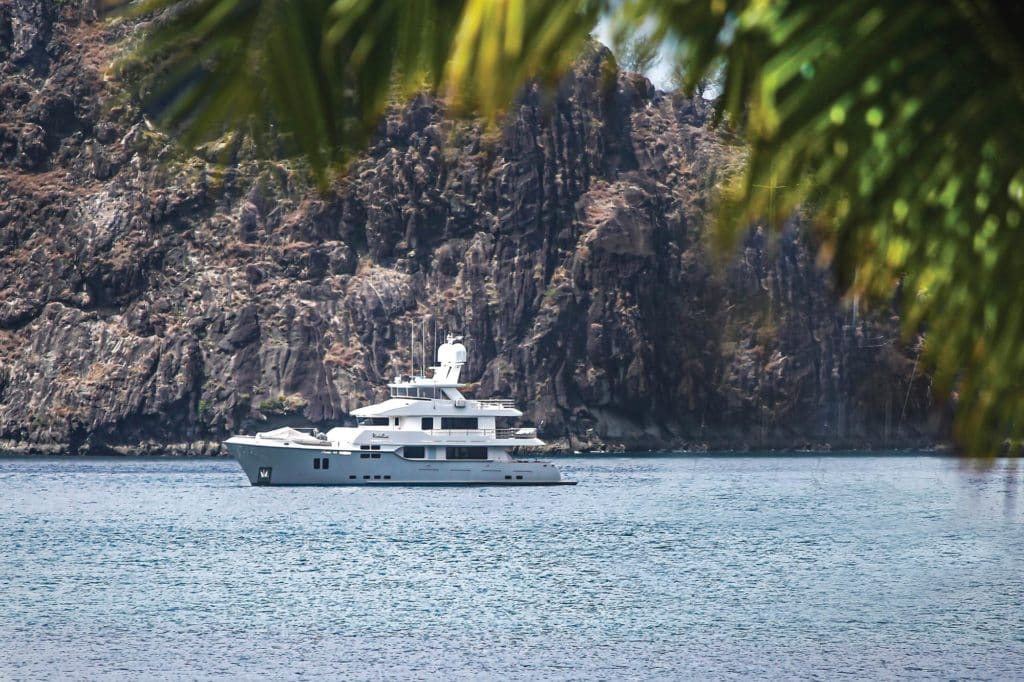
Quick Specifications
| 96’7” | |
| 24’0” | |
| 7,000 Gal. | |
| 900 Gal. | |
| 8’2” | |
| 400,000 lb. |
Beneteau Grand Trawler 62
Beneteau’s Grand Trawler 62 has 1,000-plus-mile range and 20-knot speed with twin 730 hp i6 MAN diesels . The Grand Trawler 62 is the builder’s flagship in its Trawler series, which also includes the Swift Trawler 35 , Swift Trawler 41 Sedan , Swift Trawler 41 Fly and Swift Trawler 48 . Small touches set the Beneteau Grand Trawler 62 apart. They include sea rails on all lockers to keep stowed food and gear in place, leather-wrapped interior handrails for security in a seaway, and leather drawer pulls like those found on larger yachts. Long-range cruising accommodations include a full-beam master stateroom aft, a forepeak VIP and twin-berth guest stateroom. A Quick X3 gyrostabilizer helps mitigate any potential rocking and rolling on rough days.
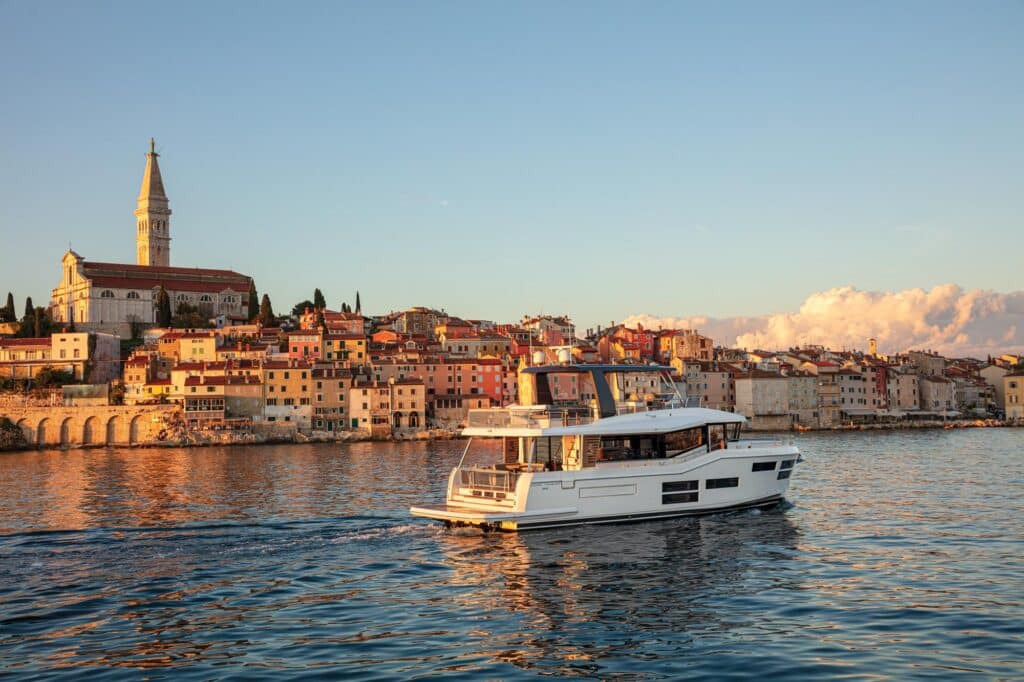
| 62’2” | |
| 17’10” | |
| 1,022 Gal. | |
| 222 Gal. | |
| 4’7” | |
| 61,729 lb. |
Kadey-Krogen 52
The Kadey-Krogen 52 is the trawler-yacht builder’s smallest offering in its raised-pilothouse series, complete with a Portuguese Bridge. Owners can choose from either a two- or three-stateroom layout, and between a single-diesel engine or twin-diesel engines, for owners seeking redundancy. The standard engine is a 231 hp John Deere diesel. With the single-engine setup, draft is 5’5” and with twins it’s a shallower 4’6”. At 6 knots, range is an ocean-crossing 4,850 nautical miles. At 7 knots, it’s 3,300 nm. At 9 knots, it 1,700 nm. The builder states, “The entire Krogen 52 is built from only three molded pieces for maximized structural integrity. There are no additional secondary bonds or caulk joints that can inevitably cause issues. All deck and superstructures are cored and vacuum-bagged to maximize strength while minimizing weight.” Additionally, six longitudinal stringers enhance overall strength.
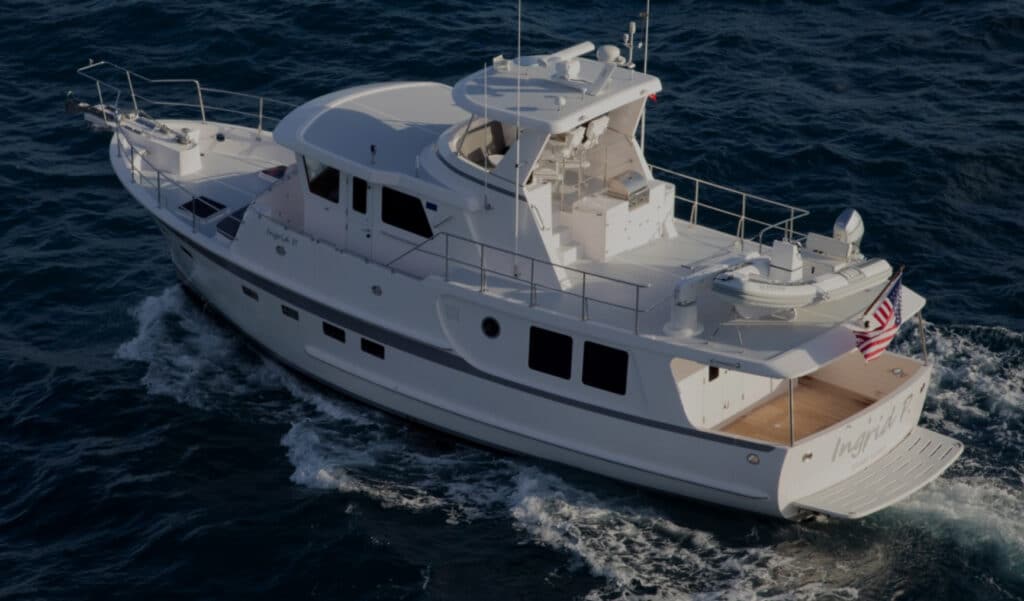
| 57’9” | |
| 17’9” | |
| 1,400 Gal. | |
| 400 Gal. | |
| 5’5” (single) 4’6” (twins) | |
| 70,000 lb. |
Bering Yachts B76
Lemanja is the first custom boat that Bering has built in this size range. The yacht is notable for its steel hull and aluminum superstructure, and for its 4,000-nautical-mile-plus range with its twin 404 hp Cummins QSL9 diesel engines. As rugged as the Bering 76 is built on the outside, it also offers homelike comforts in its skylounge inside, offering panoramic views out large windows surrounding the space. Sole-to-ceiling glass offers similar views in the open-plan salon. Accommodations are fox six guests in three staterooms with a master stateroom and two guest staterooms, plus crew accommodations. In addition to its traditional diesel engines, the B76 has a solar-rechargeable battery bank for hybrid propulsion.
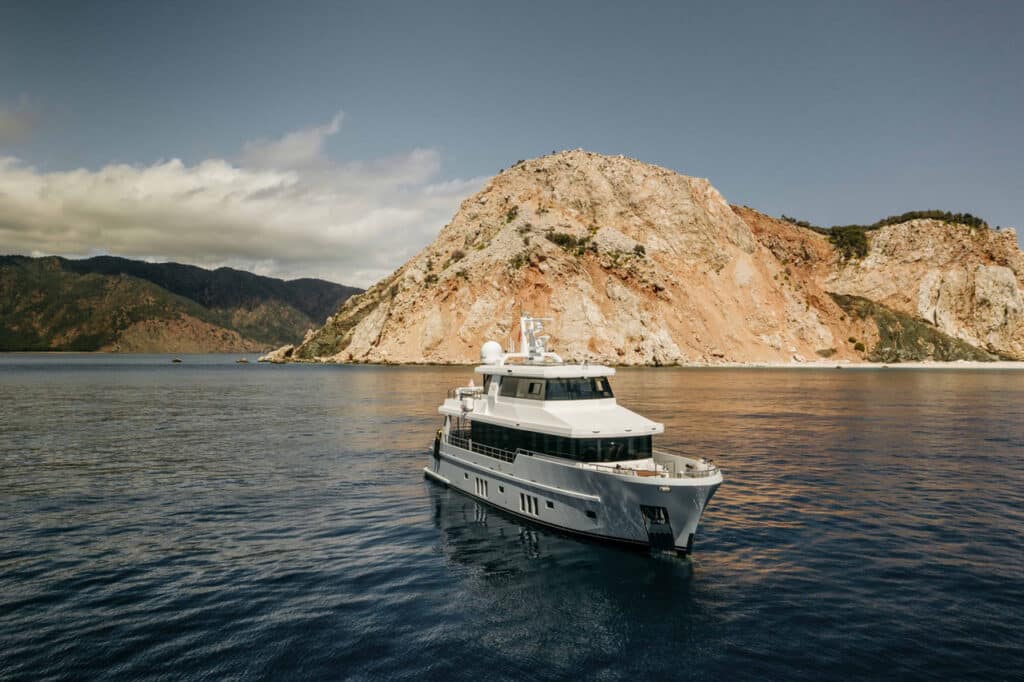
| 73’3” | |
| 19’3” | |
| 6,750 Gal. | |
| 946 Gal. | |
| 6’5” | |
| 287,000 lb. |
Ranger Tugs R-43 Command Bridge
The Ranger Tugs R-43 Command Bridge is a long-distance cruiser with creature comforts. Our expert found the R-43 Command Bridge to be a solid candidate to cruise The Great Loop . We agree. Twin Volvo Penta IPS450 pod drives give the boat efficient low and high cruise speeds at 7 and 18 knots, respectively. For those that have work during their cruise, the R-43 Command bridge’s master stateroom is set up with an office with a desk. Long trips require extra stowage and a way to clean salty clothes, so on the R-43 Command Bridge there is a washer, dryer, auxiliary refrigerator/freezer and stowage under the dinette, which rises on electric rams. Voyagers who buy a R-43 Commander Bridge can opt for a Factory Delivery Experience, which is three days of instruction on Puget Sound, and includes in boat systems, handling and maintenance.
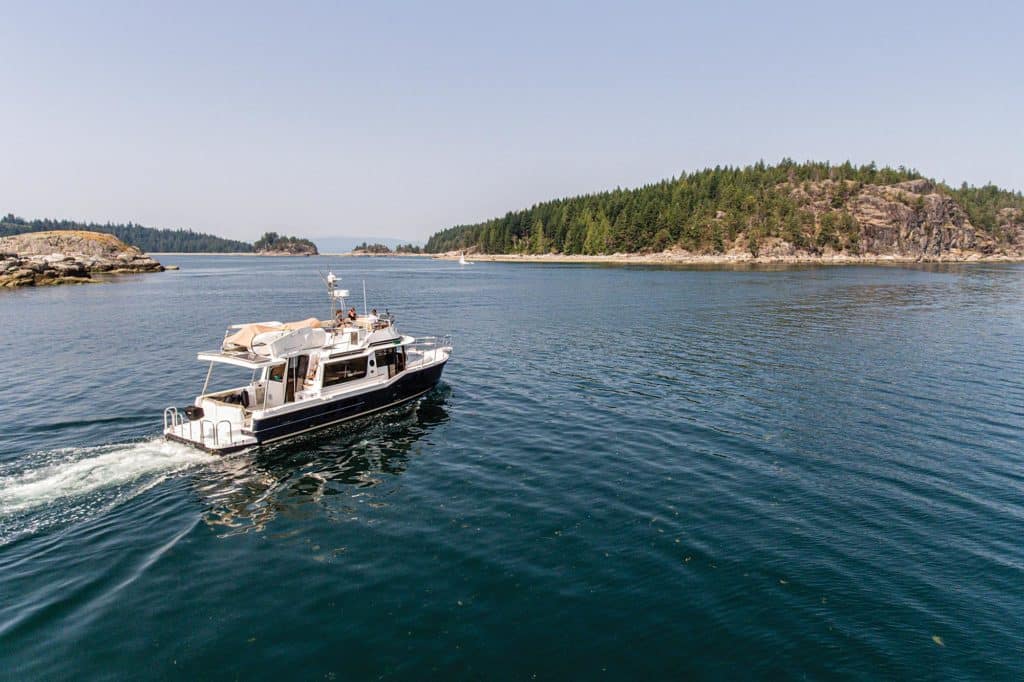
| 46’9” | |
| 14’ | |
| 300 Gal. | |
| 120 Gal. | |
| 3’6” | |
| 2/Volvo Penta IPS450s |
Beneteau Swift Trawler 48
The Beneteau Swift Trawler 48 has a 1,300-nautical-mile range at 8 knots, but can also speed away at 26 knots if the weather goes south in a hurry. Based on the builder’s 47-footer , the three-stateroom, two-head Swift Trawler 48 has a resin-infused fiberglass hull. Power is a pair of 425 hp Cummins diesels. The main-deck layout includes a galley aft setup, which is accessible to the cockpit. There, the seating and dining area can be fully enclosed, with tracks in place for side curtains. The helmsman is kept comfortable on long passages with a bolstered, pedestal bucket-style seat with a flip-up footrest. The Swift Trawler 48 we reviewed had upgraded 12-inch Raymarine HybridTouch displays (9-inch screens are standard).
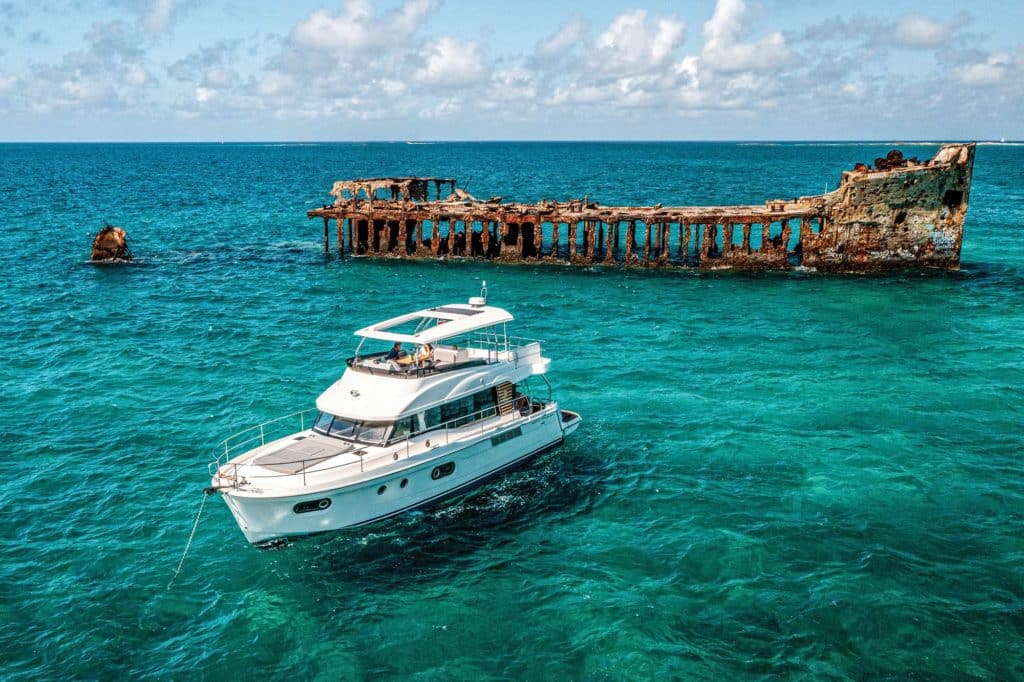
| 48’4” | |
| 14’9” | |
| 510 Gal. | |
| 169 Gal. | |
| 3’10” | |
| : | 27,896 lb. |
Kadey-Krogen 50 Open
Designed for serious extended cruising, Kadey-Krogen Yachts 50 Open provides owners with amenities that will enhance those longer passages. The galley is fitted with a Sub-Zero refrigerator and freezer, a four-burner Wolf range, a microwave and an optional dishwasher. Unlike in many trawlers and their traditional pilothouse design, the galley is located on the same level as the helm and salon. Belowdecks is the master stateroom amidships with two hanging lockers, 12 cabinets, additional drawers for stowage and an en suite head, shower and two sinks. Forward of the master is an office. The 50 Open’s hull has soft chines and a curved after end, much like the characteristics of a sailboat built for cruising. The result is an efficient hull form that provides a gentle landing into troughs when the sea gets a temper. This trawler can cruise at 6 knots for 5,000 nautical miles; 7 knots for 3,000 nautical miles; 8 knots for 2,100 nautical miles; and 9 knots for 1,200 nautical miles.
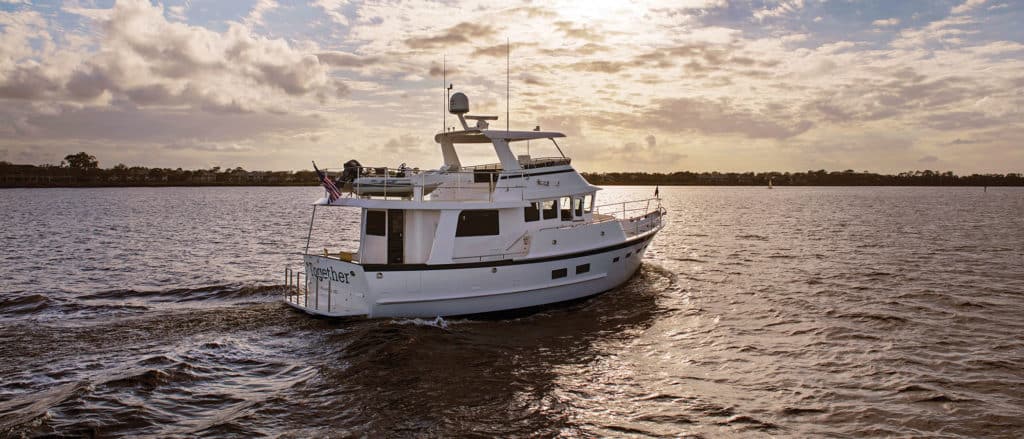
| 52’9” | |
| 17’5” | |
| 1,240 Gal. | |
| 400 Gal. | |
| 5’4” | |
| 68,000 lb. |
Outer Reef 620 Trident
Outer Reef Yachts 620 Trident delivers a three-stateroom layout and optional 600 hp Cummins diesels that allow this vessel to approach a top hop of 21 knots. Cruising speed is a little over 16 knots, burning about 34 gallons of fuel per hour at 2,750 rpm. The amidships master stateroom has 6-foot-8-inch headroom, a walk-in closet and a shower enclosed in smoked glass. In the forepeak VIP stateroom, there are seven drawers, a hanging locker, a 31-inch Samsung TV and 7-foot headroom. The portside guest stateroom can convert to an office, too. The aft galley has a U-shape countertop, a three-burner electric cooktop, a Bosch microwave and a Vitrifrigo refrigerator and freezer. Cherry, walnut and oak are the available wood options.
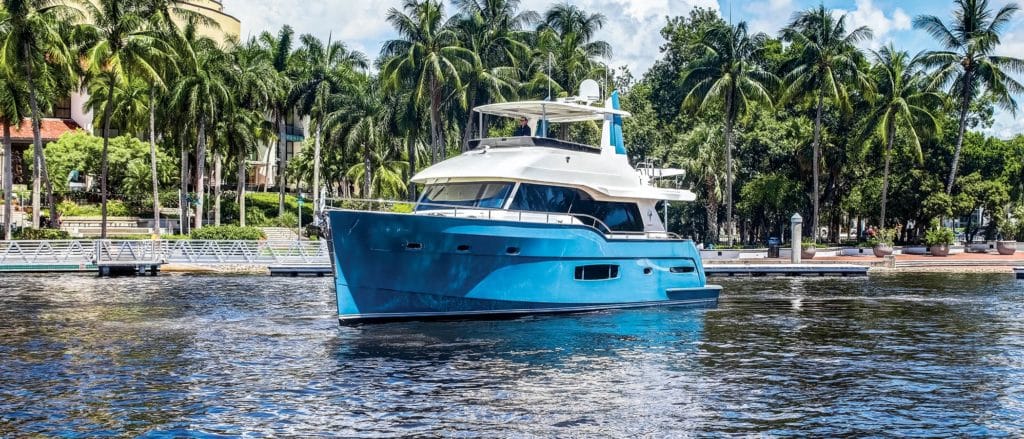
| 61’8” | |
| 16’2” | |
| 800 Gal. | |
| 185 Gal. | |
| : | 4’0” |
| : | 51,000 lb. |
Grand Banks 60 Skylounge
It’s obvious after a quick peek inside the Grand Banks 60 Skylounge that the Grand Banks Yachts trademark external DNA is retained. The deck, cabin house and skylounge are all composed of infused carbon fiber, reducing weight aloft and creating a lower center of gravity. With twin 900 hp Volvo Penta D13 diesels , the 60 Skylounge can accelerate to 31 knots and cruise at about 25 knots. The 60 Skylounge can also travel up to 2,000 nautical miles at 10 knots on a 1,530-gallon fuel tank. Twin 1,000 hp Volvo Penta IPS1200s are also available.
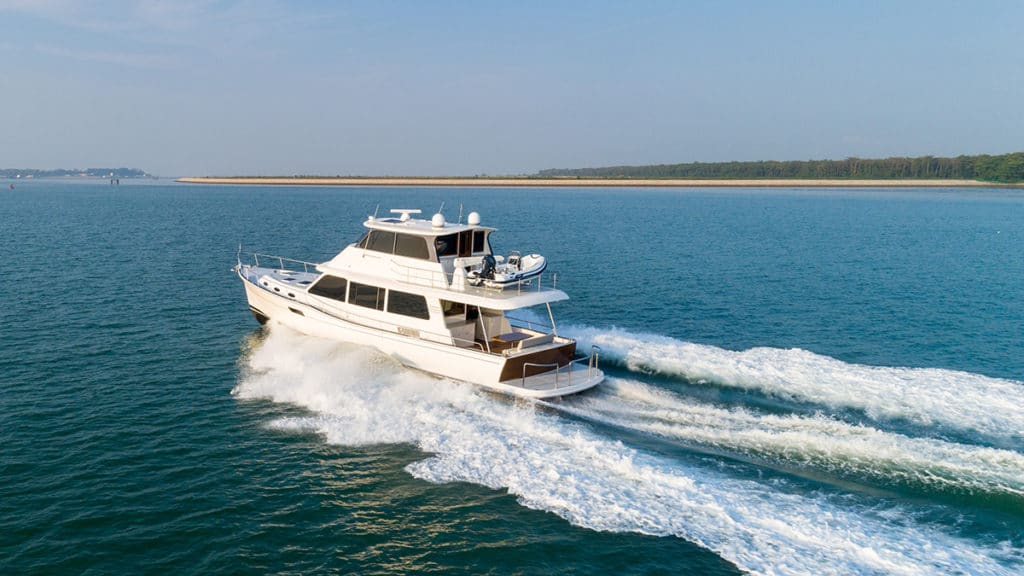
| 66’10” | |
| 19’2” | |
| 1,532 Gal. | |
| 291 Gal. | |
| 4’3” | |
| 62,832 lb. |
Krogen Express 52
The Krogen Express 52 runs on twin 440 hp Yanmar diesels and can cruise at 8 knots for 1,680 nautical miles or at 16 knots for 500 nautical miles. Top hop: 22 knots. In the interior, Krogen Express has outfitted the 52 with a master stateroom and a guest stateroom. The former has a queen island berth, more than 7-foot headroom, hanging lockers and smaller cubbies to port and to starboard, and an en suite head with a molded fiberglass shower stall with a seat, a VacuFlush toilet and a granite countertop. A power lift elevates the berth and grants access to more stowage underneath. The Krogen Express 52’s salon has a 26-inch HD LED TV and a home-theater system, leather Stressless chairs to port and a built-in, L-shape settee to starboard. The galley boasts granite countertops, a three-burner Force 10 propane range with an oven, a refrigerator, a GE microwave oven, a deep Elkay sink and a pullout sprayer faucet. There is a Buff Ultraleather Stidd helm seat for extra comfort during long runs.
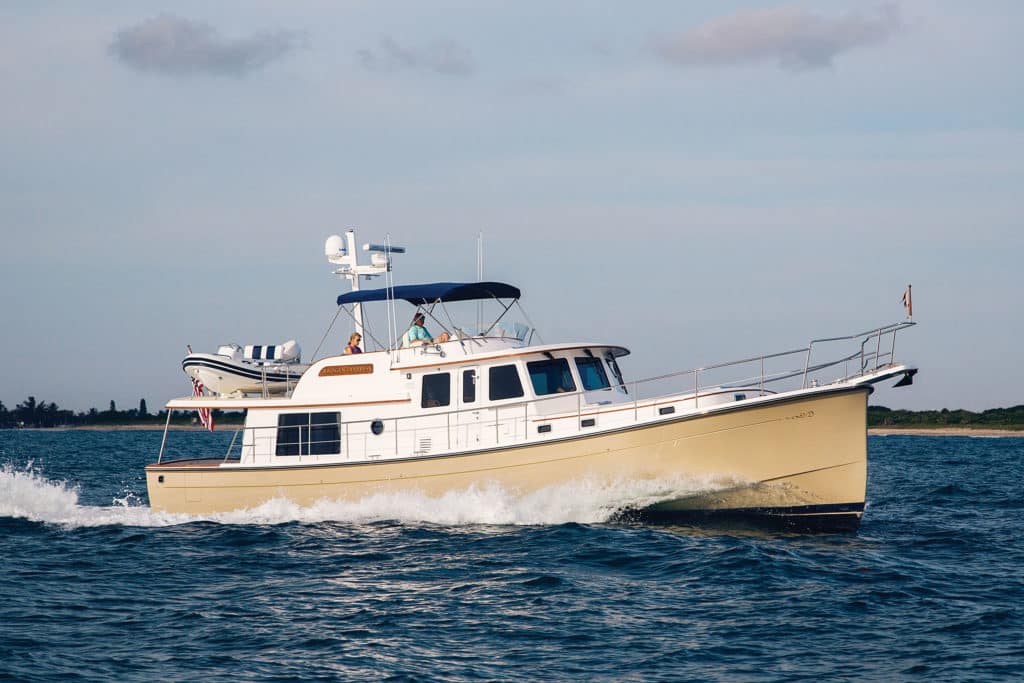
| 57’6” | |
| 15’11” | |
| 700 Gal. | |
| 370 Gal. | |
| 4’0” | |
| 43,000 lb. |
Grand Banks 85 Skylounge
The Grand Banks 85 Skylounge comes in at more than 87 feet length overall and displaces 108,000 pounds, with a 22-plus-foot beam and an air draft of just under 26 feet. Owners can choose either a three- or four-stateroom layout. The standard motors are twin 1,000 hp Volvo Penta IPS diesels, twin 1,300 hp MAN straight-shaft diesels are optional. With the larger engines, owners can also choose an optional stern thruster, in addition to the standard bow thruster. With the IPS diesels, top speed is 26.5 knots and fuel burn is 100 gallons per hour, resulting in a range of 699 nautical miles. At a 21-knot cruise speed, fuel consumption drops to 57 gph, and range climbs to 972 nm. At a 9-knot jog, fuel burn falls to 9 gph, and the Grand Banks 85 Skylounge can cruise nonstop for about 2,500 nautical miles.
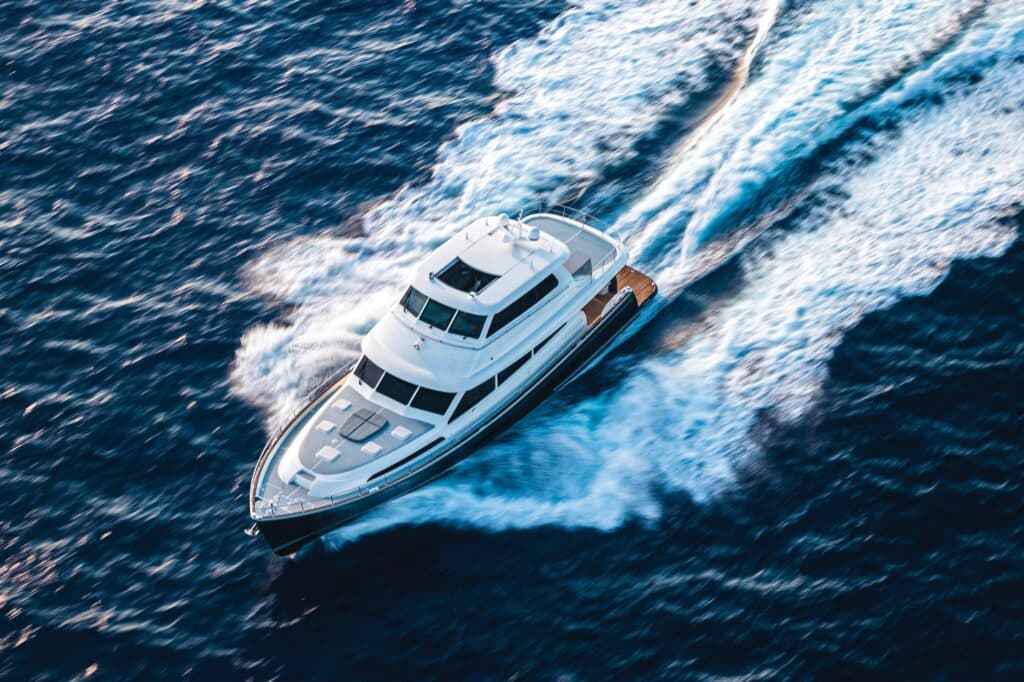
| 87’1” | |
| 22’2” | |
| 2,640 Gal. | |
| 370 Gal. | |
| 4’11” | |
| 108,025 lb. |
Vicem 82 Classic Flybridge
The Vicem 82 Classic is a flybridge model built in cold-molded mahogany, which creates a stout hull form with reduced weight. The yacht is notable for its timeless Downeast lines and strong joiner work. For cruising enthusiasts, the Classic 82 Flybridge is powered with twin 900 hp Volvo Penta D13 diesels . The yacht has a top-end speed of 17.8 knots, and the cruising speed is 15 knots. At 9 knots, and considering a 10-percent fuel reserve, range is reportedly 1,100 nautical miles. Accommodations three en-suite-equipped staterooms. The master stateroom is full-beam and amidships with a king-size berth is on centerline. The starboard-side guest stateroom and a forepeak VIP each have queen-size berths.
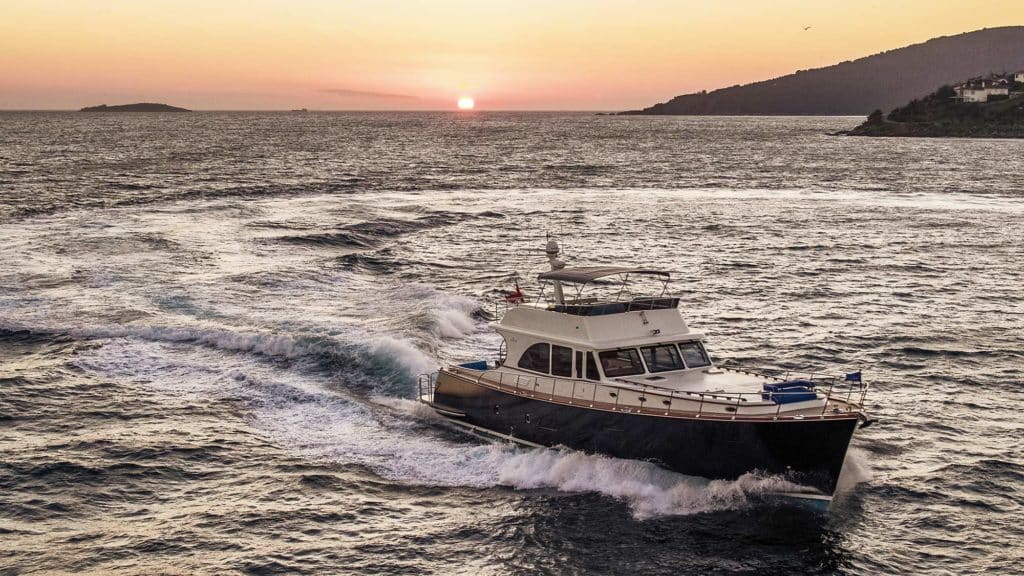
| 81’0” | |
| 20’4” | |
| 1,585 Gal. | |
| 500 Gal. | |
| 5’3” | |
| 10 Knots |
Outer Reef 610 Motoryacht
Built for an enthusiastic cruising couple after a three-year boat search, the Outer Reef Yachts 610 Motoryacht (part of the builder’s Classic series ), was customized with a fore-and-aft berth in the owners’ stateroom (as in, not athwartships), and berths rather than bunks in the smaller of two guest staterooms. This Outer Reef 610 was designed to be used as a liveaboard vessel, so the salon is not set up for dining (there are tables in the pilothouse, on the aft deck and on the bridge). A pair of swivel chairs in the salon face the built-in couch and the pop-up TV to port. The 610 is built with hand-laid fiberglass, PVC coring above the waterline, resin infusion and a vinylester barrier coat against osmosis. Power is twin 500 hp John Deere 6090 diesels turning ZF transmissions . The 610 tops out at about 13.5 knots with full tanks and 21 people aboard. The engines burn 20 gph at 1,800 rpm for 11 knots at 45 percent engine load. Those numbers should allow it to cross oceans without shortening engine life.
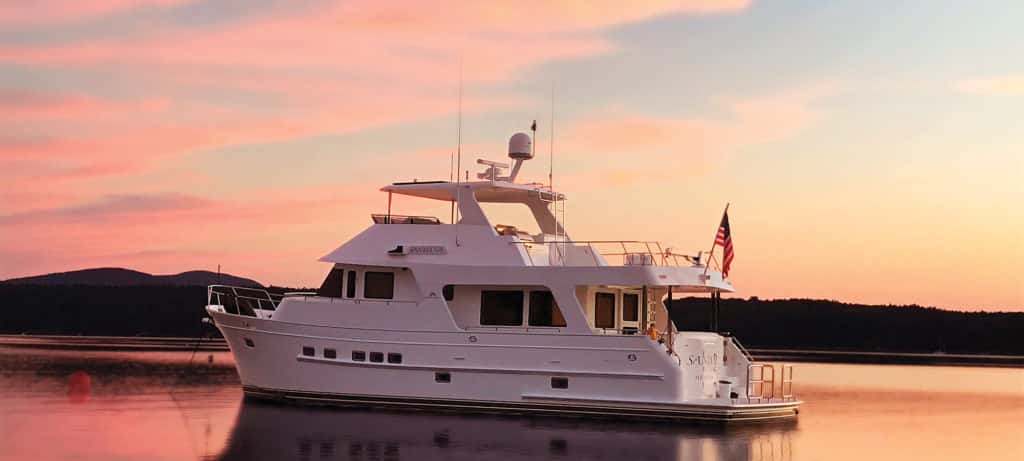
| 61’2” | |
| 17’2” | |
| 1,000 Gal. | |
| 300 Gal. | |
| 5’0” | |
| 93,000 lb. |
Nordhavn 59 Coastal Pilot
Nordhavn has long been known for its stout circumnavigation -capable craft, and the Nordhavn 59 Coastal Pilot carries on the the tradition of a beefy build with addition of…speed. Twenty-knots-plus, actually. Twin 715 hp Cummins diesel inboards and a new semidisplacement hull form are said to be key to the performance equation. The Nordhavn 59CP has a 777-nautical-mile range at a 9.3-knot cruise, and a 255-nm range at its 20.3-knot top-end. Construction is a solid fiberglass hull bottom supported by full-length longitudinal stringers and a series of transversal supports for added backbone. High freeboard should keep the decks dry in a seaway, while rails keep the crew secure during transits. Nordhavn says the 59CP has a “CE category A unlimited offshore rating, ensuring the vessel has the seakeeping and strength capabilities to take on most serious coastal cruises up to 1,000 miles.”
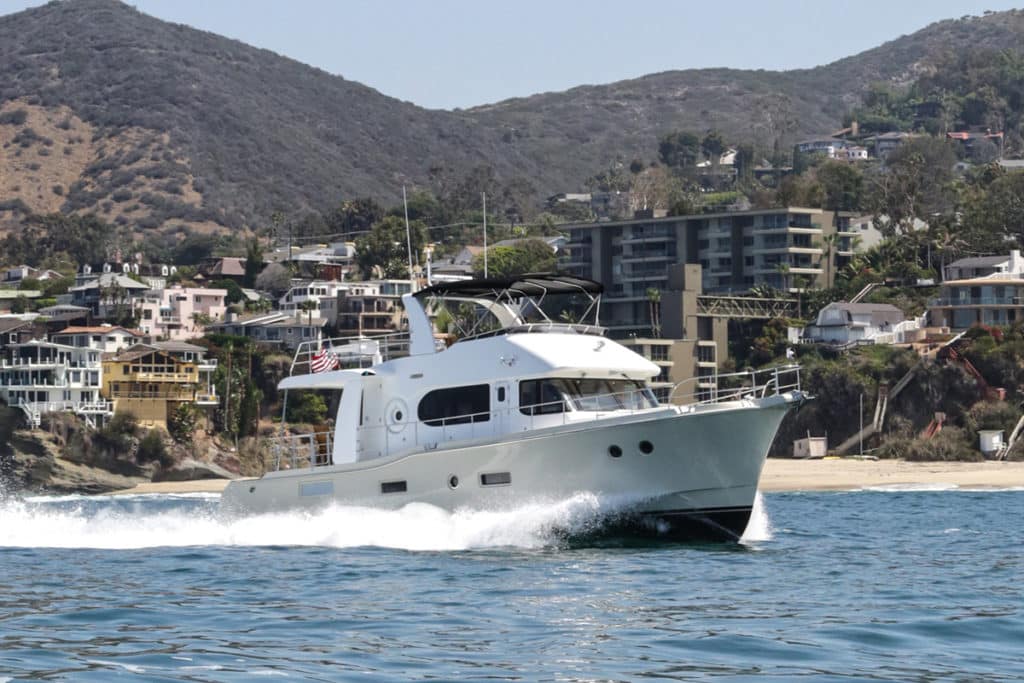
| 58’10” | |
| 17’0” | |
| 1,100 Gal. | |
| 444 Gal. | |
| 5’0” | |
| 88,000 lb. |
Marlow Yachts 58E
Following on the successful Marlow 57 , the Marlow 58E was started from scratch on a blank sheet of paper. The essence of the 58E is that it has better performance and more internal and external volume than her predecessor. The centerline length grew 10 inches over the 57, but the waterline length increased 16 inches and the beam widened 4 inches. If you were to examine the two boats out of the water, you would see more bell-shaped forward sections making for a soft impact with the vee’d portion. Power options start with twin 575 hp Caterpillar C9 diesels, but the 58E we got aboard had beefier twin 1,015 hp Caterpillar C18 diesels. Top speed: 27.9 knots. At 8 knots, the Marlow 58E can cruise nonstop for 1,400 nautical miles.
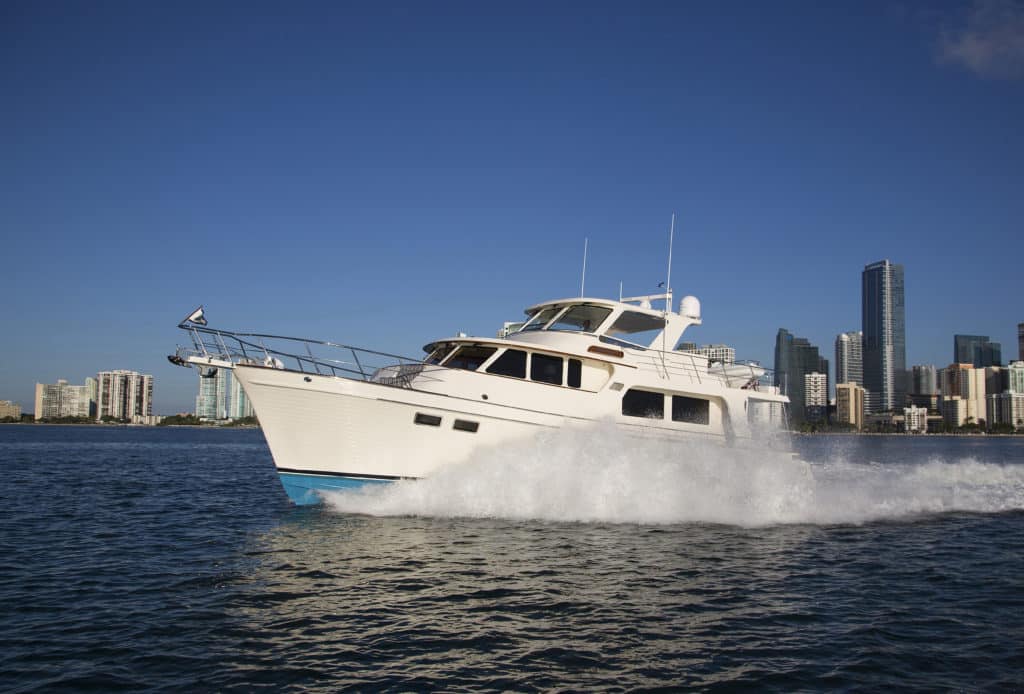
| 67’8” | |
| 18’6” | |
| 1,500 Gal. | |
| 300 Gal. | |
| 4’10” | |
| 69,000 lb. |
Frequently Asked Questions:
What is a trawler yacht?
A true trawler typically has a full-displacement hull form and robust construction to handle open-water operation, and it’s designed to operate self-sufficiently for long periods of time. They are slow-cruising vessels, but over the years, hybrid yachts called fast trawlers have emerged to offer displacement-speed operation as well as the ability to run at planing speeds when desired.
What is a full-displacement hull form?
A displacement-hull form is known is for its rounded nature and deep draft. Full-displacement vessels do not plane on the water, but rather push through the water. This hull design makes displacement-hull vessels incredibly seakindly, but it also makes them relatively slow (think 5, 6, 7, 8 knots) when compared to semidisplacement- and planning-hull designs.
Is a long-range cruiser the same as a trawler?
While all trawlers are certainly long-range cruisers, not all long-range cruisers are trawlers. True trawlers will have full-displacement hull designs and not all long-range cruisers have them.
- More: Beneteau , Bering Yachts , Grand Banks , Kadey-Krogen , Krogen Express , Marlow , Nordhavn , Outer Reef , Ranger Tugs , Trawlers , Vicem , Yachts
- More Yachts
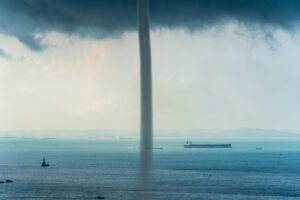
Superyacht Collision, Sinking Incident, Takeaways and Lessons
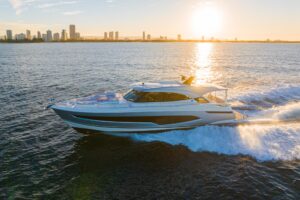
Riviera to Unveil 6800 Sport Yacht at Fort Lauderdale International Boat Show
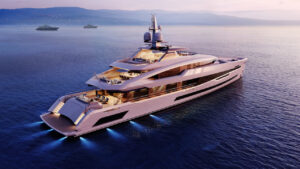
Heesen Reveals “Santosha” Details
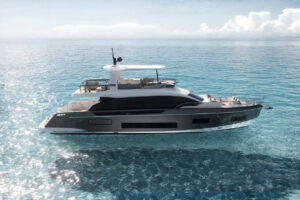
Azimut Launches the Fly 62
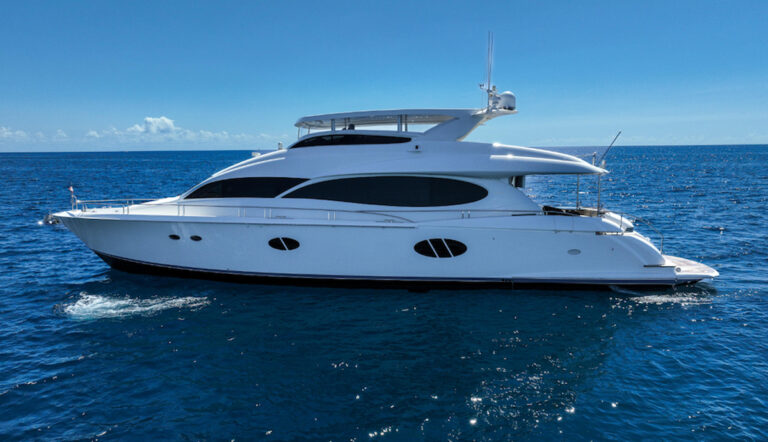
For Sale: 2006 84′ Lazzara
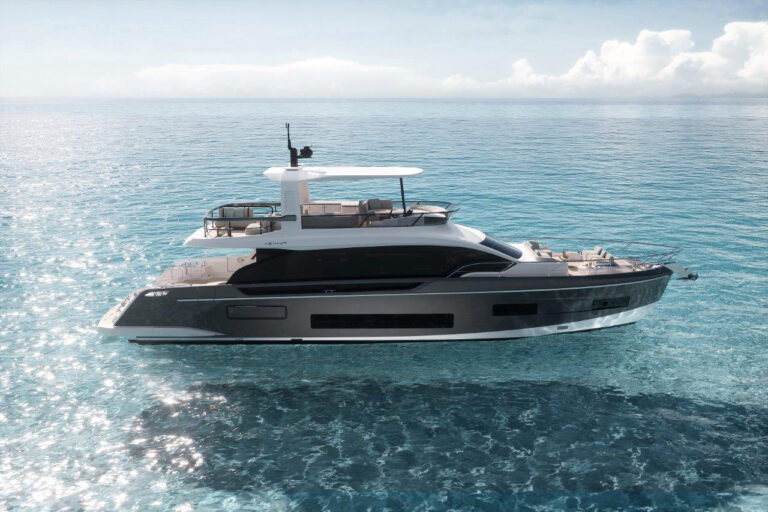
For Sale: 2015 Beneteau Swift Trawler 50
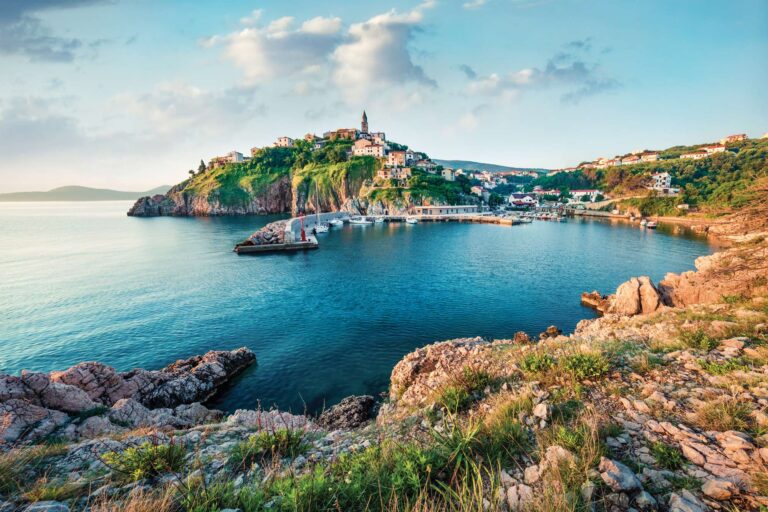
New Mediterranean Charter Options

- Digital Edition
- Customer Service
- Privacy Policy
- Terms of Use
- Email Newsletters
- Cruising World
- Sailing World
- Salt Water Sportsman
- Sport Fishing
- Wakeboarding
- Frank Magazine
- Denison History
- Virtual Tours
- Alaskan Yachts
- Azimut Yachts
- Back Cove Yachts
- Beneteau Yachts
- Benetti Superyachts
- Bertram Yachts
- Boston Whaler
- Broward Yachts
- Buddy Davis Sportfish
- Burger Yachts
- Cabo Yachts
- Carver Motoryachts
- Center Console
- Chris-Craft Yachts
- Cruisers Yachts
- DeFever Trawlers
- Dufour Sailboats
- Fairline Yachts
- Feadship Yachts
- Ferretti Yachts
- Formula Yachts
- Fountaine Pajot Cats
- Grady-White
- Grand Banks Trawlers
- Hargrave Yachts
- Hatteras Yachts
- Hinckley Picnic Boats
- Horizon Yachts
- Hydra-Sports
- Intrepid Boats
- Jarrett Bay Sportfish
- Jeanneau Yachts
- Kadey-Krogen Trawlers
- Lazzara Yachts
- Lekker Boats
- Luhrs Sportfish
- Marlow Yachts
- Maritimo Yachts
- Marquis Yachts
- McKinna Motoryachts
- Meridian Yachts
- Midnight Express
- Mochi Craft
- Neptunus Motoryachts
- Nordhavn Trawlers
- Nordic Tugs
- Ocean Alexander Yachts
- Offshore Yachts
- Oyster Sailing Yachts
- Pacific Mariner Yachts
- Palmer Johnson Yachts
- Pershing Yachts
- Prestige Yachts
- Princess Yachts
- Pursuit Yachts
- Riva Yachts
- Riviera Yachts
- Sabre Downeast
- San Lorenzo Yachts
- Sea Ray Boats
- SeaVee Central Consoles
- Selene Trawlers
- Scout Yachts
- Sunseeker Yachts
- Tiara Yachts
- Trinity Superyachts
- Viking Yachts
- Westport Yachts
Top 6 Trawlers For Cruising With Families [Yacht Buyer’s Guide]
Fast, slow, large or small — these are the best trawler yachts for family fun on the water..
Looking for a boat to accommodate your family? Look no further than the trawler, boating’s distinct type of vessel that’s designed for long distanced cruising or extended vacations. Livability and practicality make trawlers a perfect family yacht . They offer spacious accommodation and versatility in performance while being easy for the captain to maneuver.
We’re featuring the top 6 trawlers for cruising with families, currently for sale with Denison Yachting. No need to pack light when setting out on an unforgettable boating adventure aboard one of these vessels.
1. Beneteau Swift Trawler 41

The Beneteau Swift Trawler 41 is a new addition to the swift trawler fleet and an excellent option for families. She’s affordable, spacious, and great on fuel — at a top speed of 23 knots, she can drive to the Bahamas from Fort Lauderdale with plenty of fuel left to cruise around and return without a refill.
Large interior windows create an ideal galley for parents to watch the kids play in the water while making lunch. She can accommodate up to seven people with three cabins, two heads, and fully equipped amenities to enjoy long-distance cruises or weekend trips with family and friends. She’s available in a flybridge or sedan style.
The new Beneteau Swift Trawler 41 exudes safety and luxury while preserving performance and comfort. The ST 41 will be featured at the Fort Lauderdale International Boat Show 2020 — stop by to check her out or contact a Denison yacht broker for a private showing of this seaworthy cruiser.
2. 86’ Outer Reefs Yacht 2017

This 86′ Outer Reef Yacht , named Simon Says , was designed for travel. Her systems were built and optimized for sea conditions that would otherwise prevent a similar size yacht to seek shelter in the closest port. This trawler is made to accommodate a family, plus crew with eight cabins in total.
Her 3,500-gallon fuel reserve lets her sail comfortably for an extended period of time at a cruising speed that ranges from 8.5 knots to 14.5 knots. Her standout features include a sky lounge, beautiful teak, and spacious country kitchen that makes her the perfect trawler for accommodating families.
3. 70’ Marlow 2008

Pappy’s Toy is an elegant used trawler for sale with Denison Yachting. This family trawler was recently updated with a new bottom paint job, hull compound and wax, and new stabilizer seals. She’s equipped and built for long-range cruising with the help of a crew.
This 70’ Marlow is made for cruising with families because she’s comfortable, spacious, and homey. Her standout features include a wet bar, a large entertainment center, and a VIP guest stateroom. Pappy’s Toy is ready to take you on a luxury family adventure along the coasts.
4. Beneteau Swift Trawler 47

Another new addition to the Swift Trawler range is Beneteau’s Swift Trawler 47 . She offers more room and more power than your typical trawler. The ST 47 provides a true sense of comfort and the ability to take you farther and faster.
The new ST 47 features an open-deck layout, with large walkways and handrails to help passengers move around safely. Her generous cabin space can accommodate up to eight people on board the vessel. She combines those familiar characteristics of a classic long-range cruiser with the speed and convenience of a yacht twice her size.
5. 70’ Marlow 2005

Marlow Yachts were built with performance and innovation in mind. Bravo Zulu is the most well-equipped and meticulously maintained used Marlows for sale with Denison Yachting. Her updates were made with a family in mind, including a brand new electronics package, new teak decks on the swim platform, and a flybridge enclosure to protect from the elements.
Her three-stateroom, four-head layout with separate crew quarters makes her a comfortable trawler to live in. The master suite includes a king-size berth, office, and plenty of storage — there’s even a separate washer and dryer. You can easily spend weeks on Bravo Zulu and feel pleasantly at home on the water.
6. 65′ Hampton 2009

This 69′ Hampton 2009, named FeuryUs , is for sale in Old Saybrook, Connecticut with Denison Yachting. She’s in excellent condition with over $300,000 in upgrades, including new Garmin electronics, joystick dockmate remote control, and stabilizers with larger fins. FeuryUs is perfect for families or entertaining guests as she’s fully equipped with four cabins, four heads, a cozy salon, and a large aft deck. She’s stable and reliable, with plenty of space for storage and entertaining.
FeuryUs has the capability of a 1,500-mile range at 8 knots (900 rpm), but can be pushed up to 19 knots at full throttle (in case you need to outrun a storm or want to get back in time for happy hour on the dock). She’s is one of those yachts that make you feel unstoppable on the water, and she’s ready to make memories with you and your family.
Trawlers are an excellent choice if you’re in the market for a comfortable and spacious boat. Their large fuel capacity makes them ideal for long-distance cruising and overnight vacations. Contact a Denison yacht broker to find the right trawler for you and your family.
Latest News

NEWS | August 23, 2024
Cocktails & canapés at 37th america’s cup [s/y seaquell].
Cocktails & Canapés at 37th America’s Cup [S/Y SEAQUELL] Thursday, August 29th | 19:00-21:00 Denison Yachting cordially invites you to an evening of cocktails and canapés aboard the Sailing Yacht SEAQUELL during the 37th America’s Cup Round Robins at Port Forum. Enjoy a relaxed gathering on board, set against


Newport International Boat Show [Brokerage Boats On Display]
Newport International Boat Show [Brokerage Boats On Display] Thursday-Sunday | September 12-15, 2024 Denison invites you to view a number of available brokerage boats at the 2024 Newport International Boat Show. The Newport International Boat Show, set for September 12-15, 2024, in Newport, Rhode Island, is one of

NEWS | August 19, 2024
85′ azimut 2006 sold by florent moranzoni [eva].
85′ Azimut 2006 Sold by Florent Moranzoni [EVA] EVA, an 85′ (26.82m) Azimut built in 2006, was sold by Florent Moranzoni, who represented the Seller. Special thanks to James von Eiberg of Bluebnc, who represented the Buyer. EVA can accommodate ten guests in four comfortable cabins, including a
- Articles and Guides
Best Trawler Yacht Brands for Bluewater Adventures
16th nov 2023 by samantha wilson.

The rise of the trawler yacht is one of the most exciting developments in the boating industry in decades. It has opened the world of long-range travel to those who don’t care to sail and whose budget doesn’t run to a superyacht or explorer yacht. It has actually filled a gap that we didn’t even realize we desperately needed. Imagine being able to cruise the world in comfort on a yacht under 60 feet, or even under 40 feet. Or being able to cruise across blue water, with several guests staying aboard, to far-flung destinations on a yacht the size of a cabin cruiser.
Trawler yachts are almost an oxymoron—the idea of a sturdy and functional fishing trawler being a luxury yacht would once have been laughable. But today that’s exactly what these robust, spacious, and elegant long-range cruisers are. Here we take a look at our pick of some of the best trawler yacht brands on the market;
Written By: Samantha Wilson
Samantha Wilson has spent her entire life on and around boats, from tiny sailing dinghies all the way up to superyachts. She writes for many boating and yachting publications, top charter agencies, and some of the largest travel businesses in the industry, combining her knowledge and passion of boating, travel and writing to create topical, useful and engaging content.

More from: Samantha Wilson
Related Articles and Guides
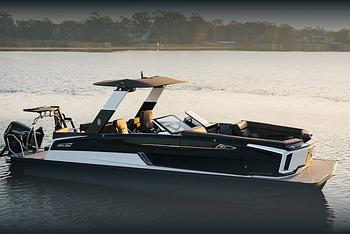
16th Aug 2024
Best Luxury Pontoon Boat Brands Have it All: Glamor, Speed, Fishing, Waterslides...
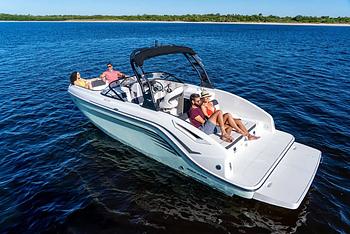
10th Aug 2024
Deck Boat vs. Bowrider: Which Runabout is Best?

19th Jul 2024
The World’s Best Yacht Brands
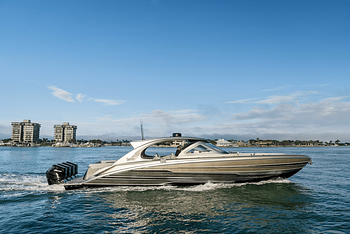
12th Jul 2024
Top Performance-Boat Brands, Where There’s Something For Everyone

- Explore Rightboat
- Boats for Sale
- Boating Articles
- Buyers Guide
- About RightBoat
- Sell Your Boat
- Boat Selling Advice
- All manufacturers
- All categories
Enter your email to keep up to date with the latest news
Join for free
Sign up now for free and discover how easy it is to keep up to date with THE latest boats for sale. Find your right boat, and tailor your voyage to finding your next boat.
Benefits of becoming a member:
- Set up tailored alerts
- Personalise your experience
- Download full specifications and broker details
- Keep tabs on your favourite boats
Are you a broker? Join as a Broker
Rightboat - join for free.
Do you have an account already? Login
Save this search
Save your search and receive new boats in your email..
You can unsubscribe from your alerts whenever you like. By pressing the button you accept the Legal Terms and conditions
11 best Trawler Boats for Long-Distance Cruising
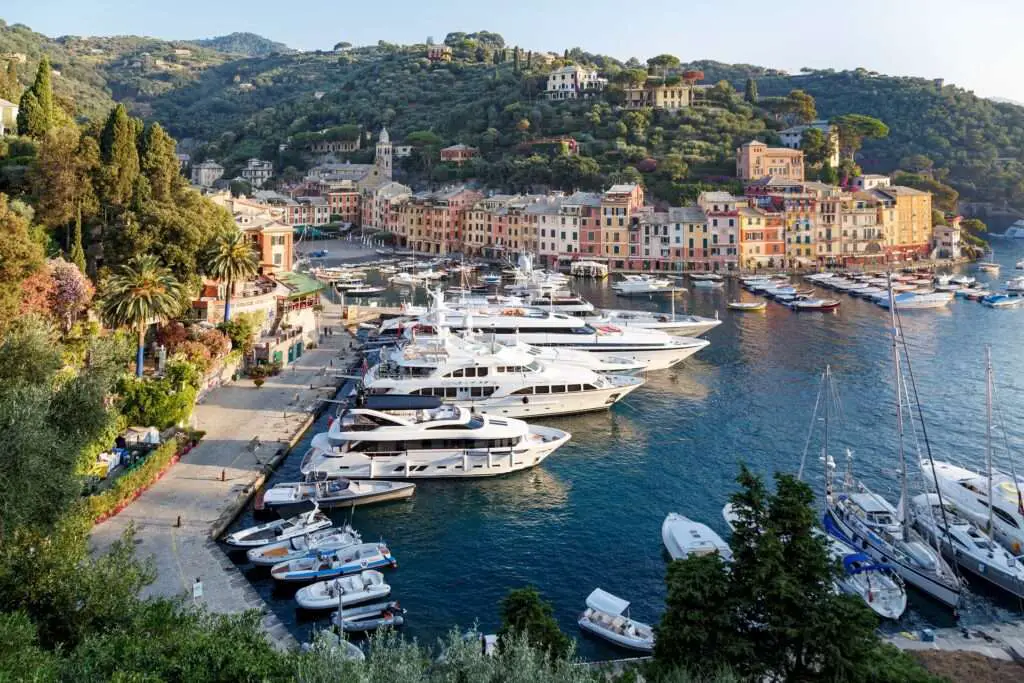
Are you looking for the perfect companion for your next long-distance cruise? Look no further! We have put together a comprehensive list of the 11 best trawler boats available, so you can find your ideal boat.
Whether you’re looking for a sturdy and reliable vessel, or something more luxurious and stylish, this list has it all. Read on to learn more about these incredible trawler boats and find the perfect boat for your next journey.
Table of Contents
Kadey-Krogen Yachts
If you’re looking for a trawler boat that will take you on a comfortable, long-distance cruising journey, Kadey-Krogen Yachts is a brand you’ll want to explore.
This company has been building top-quality trawlers for over four decades and has built up a loyal following of happy cruisers.
- One of the reasons Kadey-Krogen Yachts is so popular is the brand’s focus on livability and comfort.
The boats are designed with spacious and comfortable living areas, making them ideal for extended trips.
You’ll find plenty of storage space, well-appointed galley areas, and luxurious sleeping accommodations onboard Kadey-Krogen trawlers.
- Another standout feature of Kadey-Krogen Yachts is their focus on safety and durability.
These boats are built to last, with robust hulls and advanced safety features like collision bulkheads, watertight compartments, and sturdy handrails throughout.
If you’re looking for a trawler boat that is both comfortable and capable, a Kadey-Krogen Yacht may be the perfect fit for you. With several models to choose from, you’ll be able to find the right boat to suit your cruising style and preferences.
For those seeking a truly world-class trawler boat, Nordhavn is the answer. The brand has built a reputation for producing luxurious vessels that can take on even the most demanding conditions.
Nordhavn’s lineup ranges from 40 to 120 feet, but regardless of the size, you can always expect a top-quality yacht that is both durable and efficient.
The company is renowned for its hull design, which has been tested and proven to withstand rough seas.
- One of the standout models in the Nordhavn range is the Nordhavn 60. This is a perfect boat for extended cruising with family and friends.
The boat features a spacious and well-appointed interior with multiple living areas, including a fully equipped galley and salon.
- Additionally, the Nordhavn 60 is equipped with all the latest navigation and safety systems, ensuring a smooth and secure journey.
With its high-quality construction, modern features, and timeless design, the Nordhavn 60 is a great choice for anyone looking for a premium trawler boat.
- The Lowdown on Trawler Boating for Beginners
- Which Boat is Right for You: Trawler or Motor?
- Top 11 Pontoon Boats for Serious Anglers
- Beneteau Boat: 11 Things You Should Know
Grand Alaskan
The Grand Alaskan trawler is a popular choice for those seeking a spacious and comfortable long-distance cruising vessel.
Built with quality materials and meticulous attention to detail, these boats offer a range of sizes and configurations to fit different needs and preferences.
The Grand Alaskan 60 is one of the largest models in their lineup and offers a luxurious living space with four staterooms, four heads, a large salon, and a fully equipped galley.
The yacht also has a spacious flybridge, which provides ample seating for guests to enjoy the view while cruising.
Additionally, the boat features a well-designed engine room with excellent access to all components for easy maintenance.
The Grand Alaskan 60 is powered by twin diesel engines , which can provide a cruising speed of up to 12 knots and a range of over 1,000 nautical miles.
With a comfortable ride and impressive fuel efficiency, the Grand Alaskan is a perfect option for long-distance cruising and exploring new horizons.
Whether you’re looking for a weekend getaway or a long-term liveaboard vessel, the Grand Alaskan trawler offers all the comfort and performance you need to make your cruising dreams a reality.
Ranger Tugs
For those seeking a more compact trawler boat, the Ranger Tugs are a great option. These vessels range in size from 21 to 31 feet and are perfect for those who want a cozy yet functional boat for long-distance cruising.
Despite their smaller size, the Ranger Tugs have a lot to offer. They have efficient engines that are easy to maintain, as well as spacious cabins that make them comfortable for extended stays.
The boats also have excellent maneuverability, allowing for easy docking in tight spaces.
- One of the standout features of the Ranger Tugs is their use of solar power.
Many of their models come equipped with solar panels, which not only reduce your carbon footprint but also allow you to stay out on the water for longer without worrying about your batteries running out of charge.
- Some popular models in the Ranger Tug lineup include the Ranger R-27 and the Ranger R-31.
The R-27 has a spacious cockpit and can sleep up to six people, while the R-31 has a more luxurious interior with a master stateroom and a separate guest room.
If you’re looking for a smaller trawler boat that doesn’t skimp on comfort and functionality, the Ranger Tugs are definitely worth considering.
Here is a good video to walk you through Ranger tug 23
Passport Yachts
If you’re in search of a trawler boat that offers elegance, luxury, and unmatched performance, Passport Yachts is definitely worth checking out.
Founded in 1979, this US-based manufacturer produces yachts that are known for their superior craftsmanship and attention to detail.
- One of the most popular models from Passport Yachts is the Passport 470. With its beautiful teak interior, spacious saloon, and comfortable cabins, this boat is perfect for long-distance cruising.
The boat is powered by a reliable Yanmar diesel engine and is equipped with top-of-the-line electronics, including radar, GPS, and autopilot.
- Another model worth considering is the Passport Vista. This boat offers exceptional stability, even in rough waters, thanks to its deep-V hull and advanced stabilizer system.
It also features a large swim platform and spacious cockpit, making it ideal for outdoor activities.
Overall, Passport Yachts is a top choice for those who want a trawler boat that combines style, performance, and comfort.
Here is a good video to walk you through Passport Yachts 545
Selene Yachts
If you’re in the market for a trawler boat that can take you on long-distance cruises, Selene Yachts is one brand worth considering.
Their yachts are designed for ocean-crossing and are equipped with modern navigation and communication systems for a safe and comfortable voyage.
- One standout feature of Selene Yachts is their fuel efficiency. Their boats are designed to be more fuel-efficient than traditional trawlers, which can save you money in the long run.
The yachts are also built to withstand rough seas, thanks to their sturdy construction and reinforced hulls.
- Selene Yachts offers a range of models, from the 38-foot Selene 38 to the 92-foot Selene 92 Ocean Explorer. Each model is designed with spacious interiors and comfortable living areas, perfect for long stays at sea.
They also have a variety of customization options available, so you can design your yacht to fit your specific needs and preferences.
Overall, Selene Yachts is a top choice for those seeking a reliable and efficient trawler boat for long-distance cruising.
American Tug
If you’re looking for a trawler boat that is both comfortable and easy to handle, the American Tug might just be your perfect companion.
With a range of over 1,000 nautical miles and a cruising speed of up to 17 knots, this vessel is designed for long-distance cruising .
- One of the most notable features of the American Tug is its hull design, which allows for a smooth ride even in choppy waters.
It also has a spacious and well-appointed interior, complete with a full galley, a large salon, and comfortable sleeping accommodations.
- In addition to its impressive performance and amenities, the American Tug is also built to last.
Constructed from high-quality materials, including a hand-laid fiberglass hull and a solid teak and holly interior, this vessel is both durable and beautiful.
Whether you’re looking to take on the open ocean or simply enjoy a leisurely cruise through your favorite waterways, the American Tug is a top choice for trawler boat enthusiasts.
Fleming Yachts
Fleming Yachts is another popular name in the world of trawler boats. Known for their high-quality craftsmanship, Fleming Yachts has been creating exceptional vessels for over three decades.
- Their flagship model, the Fleming 55, is a top pick for long-distance cruising. This yacht features a sleek, elegant design and offers all the amenities needed for extended journeys.
With its spacious and comfortable interior, the Fleming 55 is perfect for couples or families looking for a luxurious and reliable boat for extended voyages.
- Another standout model from Fleming Yachts is the Fleming 58.
This boat offers even more space and amenities than the Fleming 55, making it a great choice for larger groups or those looking for a bit more comfort on their long-distance cruise.
Fleming Yachts’ commitment to quality and attention to detail is evident in every aspect of their boats.
From the finely crafted woodwork to the high-end finishes, Fleming Yachts produces vessels that are built to last and designed for maximum comfort and enjoyment on the water.
Krogen Express
The Krogen Express is the perfect combination of classic design and modern engineering. With a sleek and elegant exterior, this trawler boat has exceptional fuel economy and cruising speed .
The Krogen Express comes in three different sizes: 49′, 52′, and 56′. Each model has an interior layout that is designed for comfort, with a spacious salon and galley, as well as luxurious staterooms.
- The Krogen Express has a unique hull design that delivers exceptional performance and stability even in rough seas.
With a cruising speed of 16 knots and a range of 2,000 nautical miles, the Krogen Express is a perfect choice for long-distance cruising.
The yacht’s shallow draft also allows for cruising in more secluded anchorages, perfect for a private escape.
- The Krogen Express boasts advanced technology, including a digital helm display, integrated entertainment systems, and a robust power management system.
The boat also has exceptional safety features, such as high bulwarks, a Portuguese bridge, and wide walkways that provide easy and secure passage from bow to stern.
The Lanty trawler boat is a smaller vessel, making it an ideal option for couples or solo cruisers looking to explore the open water.
- Despite its size, the Lanty is still equipped with all the necessary amenities for comfortable cruising, including a full galley and comfortable sleeping quarters.
This boat also boasts excellent fuel efficiency, allowing it to travel long distances without having to refuel often.
- The Lanty is also designed with ease of use in mind, featuring a single-engine setup and a joystick for easy docking .
One unique aspect of the Lanty is its customizability. Owners have the option to choose from a variety of layout options and finishes to make the boat fit their specific needs and preferences.
Defever Cruisers
If you’re looking for a trawler boat that can handle long-distance cruising with ease, you might want to consider a Defever Cruiser.
These boats were designed by Arthur Defever, a naval architect who is known for his expertise in designing long-range cruisers.
- The Defever Cruiser line is known for its seaworthiness, durability, and spacious interiors.
These boats typically feature a semi-displacement hull , which allows for comfortable cruising at slower speeds while still providing good fuel efficiency.
- One popular model in the Defever Cruiser line is the 44 Offshore Cruiser, which features a spacious interior with two staterooms, two heads, and a large salon.
The boat’s large aft deck and flybridge provide ample space for entertaining and taking in the views while cruising.
- Another popular model is the Defever 49 Pilothouse, which offers more living space and an additional stateroom compared to the 44 Offshore Cruiser.
The boat’s pilothouse provides a commanding view and can be used as an additional living space or office.

NORDIC TUGS
NORTHERN MARINE
BULLFROG BOATS
MY YACHT WORTH?
- USED YACHTS
FEATURED LISTINGS
YACHTS BY BUILDER
YACHTS BY LOCATION
YACHTS BY TYPE
WHY LIST WITH US
- BUYING A TRAWLER YACHT
- TRAWLER BOAT BUYER'S GUIDE
FT LAUDERDALE
MARINA DEL REY
SAN FRANCISCO BAY
VICTORIA B.C.
- SERVICE - PNW
FLOTILLA EVENTS
SEATTLE SAILING ACADEMY
- JOIN OUR TEAM
The Ultimate Trawler Boat Buying Guide

I have been writing about trawlers and powerboat cruising for many years. It is both an obsession and a fascination for me, as I witness hundreds of people, mostly couples, embrace the trawler lifestyle as a healthy alternative to routine living on land. While the last several years certainly got a lot of people and families to escape from a confined existence, choosing a freer life on the water away from so many imposed restrictions, the trawler lifestyle was already alive and well in North America.
(Below: "Growler", a Custom Zimmerman 36 Trawler once owned by Bill Parlatore, founder of Passagemaker Magazine.)

What is the appeal of this lifestyle? For me, living aboard and operating trawler yachts represents a quality of life that embraces the values of self-sufficiency and independence, and adventure without sacrificing comfort. One is free to move as the mood dictates, finding a balance of nature while engaging as much—or as little—in society, careers, and other activities that compensate with convenience, glittery things, nice cars and houses, and other material things. Many come to realize at some point they are but distractions from a more grounded existence.
Operating a trawler does not demand the skills and experience required from a similar size sailboat . And it is relatively easy to learn the nuances of engine and vessel maintenance, navigation, and proper seamanship. Depending on what kind of powerboat one chooses, they can be economical to own and operate, and offer a pleasant home experience that often rivals luxury living ashore. And a point often missed when discussing this lifestyle, the skills needed to competently run a trawler offer stimulating physical and mental challenges that are immensely valuable at the stage of life when most of us pursue this life direction.
It is rewarding to gain confidence and a sense of accomplishment with every new port, every new challenge. Dealing with the vagaries of life on the water makes one stronger, more resilient, and better able to deal with just about anything life throws at us. A t-shirt captured that sentiment: “Calm seas never made a skilled sailor.”
And a final note before I begin. While we’ll look at the cost of admission into this life, most of us are at a point in life where we have more financial worth than time, so the cost of getting into this lifestyle is more than made up by a quality of life that most agree is hard to beat.
This guide to buying a trawler yacht serves several functions, and I hope to satisfy them in the following pages. We will discuss the choices one has in the trawler market, and hopefully explain the value of each type as it relates to selecting the right boat. At the same time, I hope to underscore this discussion with a greater appreciation for what I believe is often missed. Choosing the right boat is only the beginning. There is much more to the selection process than simply choosing a layout that seems comfortable or a boat that comes with all the bells and whistles. Walking through a boat during a boat show is only the first taste of what a boat has to offer. I trust my guide will help people avoid falling in love with the wrong boat. If I am successful, we will keep such misplaced passion to a minimum.
TRAWLER BUYER'S GUIDE - TABLE OF CONTENTS
- What Is A Trawler?
- What Are The Different Types Of Trawler Boats?
- What's The Difference Between Trawlers & Cruising Boats?
- What About Catamarans?
- Hybrid & EV Powerboats
- How Many People To Take On Your Trawler?
- Where Should You Take Your Trawler?
- How Long Should You Cruise On Your Trawler?
- What Does A Trawler Boat Cost?
- Completing The Process Of Buying A Trawler
I. What is a Trawler Anyway?
I looked back at some of the references and definitions I offered over the years, as well as those presented by our editors. I keep coming back to the one that still resonates best with me, even as I look over the current field of trawlers and cruising yachts out there. Some are very similar to what was sold years ago, but not all, and each supports a lifestyle that is capable, comfortable, and relatively easy.
I am confident that, as we get ready to start 2024, the word “trawler” is best considered a metaphor for the cruising lifestyle it so well represents. Yacht brokers may disagree with me, but I stand firm. Back in the 1960s, power cruising pioneer Robert Beebe suggested that boats aren’t good for “voyaging” under power if they do not strongly resemble “true” trawlers. He referred, of course, to those husky fishing vessels that remain at sea for long periods, surviving anything the weather and sea throws at them, and safely bringing the catch and crew home when the job is done.
Today that analogy is not even remotely fitting for many powerboats that can capably make passages at sea, complete extended coastal and inland cruises, and serve as comfortable and safe homes for their owners. There has been a continuous evolution of the cruising powerboat genre for years now, and they now come in an assortment of styles, hull shapes, and sizes. And there is no better time than now to look at the field of available trawler choices.
In addition to traditional yacht designs that continue to be refined, we now also have new choices that really push the envelope beyond traditional shapes and concepts. And the introduction of powerful and reliable outboard propulsion has brought along a new category of cruising boats that simply did not exist before.
It is all very exciting. I once observed that comparing the cruising characteristics of a full displacement steel trawler to a displacement power catamaran or a larger Downeast cruiser is pure folly. Each can make a superb cruising boat for owners. Which is the better athlete: a football player, a hockey goalie, or a ballet dancer?
Once you understand the many kinds of boats on the market today, and the choices you have, given your budget and other considerations, it is important to match whatever boat you choose to your style of cruising. This is at the heart of this buyer’s guide. Yes, it is vital to know what is out there to choose from, but it is even more critical to understand your needs and what kind of boat will best fit those needs. While this may be a challenge for some, hasty mistakes can lead to broken plans, create unnecessary anxiety, and put an unfortunate end to one’s dream cruising plans. All of which is totally avoidable.
Let’s begin with a practical look at the main types of hull shapes to understand the positive and negative aspects of each as they relate to cruising. Then we’ll look into how they may fit your needs.
(Below: Trawler owners meet up during the Pacific Northwest Nordic Tug Owners Rendezvous. Also called PANNTOA .)

II. Choices Come in All Shapes
Full Displacement
What was once the only real choice for those intending to cruise under power is the full displacement hull shape. It is the earliest form of powerboat and most commercial and fishing vessels are of this type. It is the most seaworthy and efficient hull shape. Many popular cruising boats are full displacement, such as:
- Northern Marine
- Hatteras LRC
- And dozens of custom steel and fiberglass trawlers.
These vessels travel efficiently through the water, with no unnecessary energy spent trying to lift the hull up onto the wave in front. They are well matched to lower horsepower engines, as they offer minimal resistance going through the water.
These boats are very forgiving at sea, which makes them very seaworthy. Rather than resist wave action, they give way, and roll to let the wave energy pass by rather than resist it, which keeps them safe at sea.
The full hull shape has the most volume for a given length, which translates into superior inside dimensions for accommodations, large tankage, and exceptional storage. They make fantastic liveaboard boats and for long distance cruising these small ships can carry all your stuff. Onboard weight is not an issue compared to any other type of hull shape.
(Below: A Northern Marine 57 is a good example of a full-displacement trawler yacht.)

Again, the low energy requirements to travel through the water, rather than try to get on top of it, means they are best powered by relatively small diesel engines to run at the displacement speeds within the maximum hull speed of 1.34 times the square root of the waterline length. This is Froude’s Law and is the limit of their speed potential. Combine this lower horsepower engine with huge fuel tankage and owners have the range to travel long distance. In some of these full displacement trawlers, one can make across-and-back ocean crossings, or enjoy a full year of cruising, without stopping to buy fuel.
For efficient and economical cruising, a full displacement trawler is the way to go, for many reasons. Rather than bother with the generally tedious sailboat mentality of electrical and battery load management, owners of full displacement trawlers just don’t worry about it. The boat is fitted with one, two, or even three generators that supply all the electrical power needed to run even a full suite of domestic galley appliances, HVAC, and pilothouse electronics.
Not only do these gensets make for relatively unlimited self-sufficiency whenever the trawlers remain at anchor, but the better builders take advantage of the hull volume to thoughtfully plan accommodations during construction. Generators are then strategically located to minimize noise and vibration throughout the boat. Just like being on a small ship, one is vaguely aware that a generator is running somewhere. The boat is designed and built around that concept, so there is always plenty of quiet, available electrical power. Whatever sense that one has of distant humming from running machinery, it is nothing more than evidence of shipboard activity. I have always loved the sense of independence and freedom it provides. On the right boat, it is so muted that it does not detract from the feeling of being one with nature, as when alone in a quiet anchorage tucked inside a rugged Alaskan island coastline.
Some high-end expedition trawlers go one step further. Northern Marine, for example, often designs the boat around a pair of identical 20kW generators to share generating duty. There might also be a small third unit for nighttime use when loads are much reduced. And much like the commercial and working vessels that are the heritage behind the company, nothing is hidden or tucked away. Serious business demands serious access.
(Below: The Northern Marine 57 has two 20kW generators for long-distance adventures.)

There is always a downside, of course. Full displacement boats are limited in speed, and cruising at 7-10 knots is about all one can expect no matter how much horsepower one theoretically adds. It is simply a full shape traveling in its sweet spot in the water. But in conditions where lesser yachts need to slow down to handle the rough seas, these boats just continue on at their normal cruising speed, no big deal and perfectly safe.
The other issue is that such seaworthiness comes at the expense of rolling in a seaway. Yes, it is why these boats are so safe. But it can be uncomfortable for crew, and over time can wear down even the hardiest crew.
That is why most full displacement boats have some form of stabilization. They lack sails to remain steady. These trawlers instead rely on some form of stabilizing technology, either active or passive, and they are quite effective reducing rolling at sea. Active fin stabilizers, flopperstoppers, gyrostabilizers, even flume tanks, have been used with varying degrees of success to manage the roll of a full displacement yacht. And active systems keep getting better, with more sensitive electronic controls and sensors to reduce movement. The current generation of gyro systems, such as the SeaKeeper, are proving popular in the trawler community and for good reason.
Full displacement boats are not the best for close quarter maneuvering, especially as many have a single diesel engine. Learning to drive a big displacement trawler is a worthy skill to develop as it builds confidence. One must understand the ship’s main rudder is designed and sized for optimum performance at sea, not close quarter maneuvering. That is why these boats have bow and stern thrusters. Just like every commercial ship out there. The right tools for the job.
Another potential downside of this hull shape has to do with where one cruises. These boats typically have deeper draft and so would not be ideal for shallow water cruising as one is finds in the Florida Keys, the ICW, and the Bahamas and Caribbean.
Having gone many thousands of miles on full displacement trawlers, I have great respect and appreciation of the beauty of this hull shape. Once out of sight of land, speed becomes the speed du jour, no big deal without reference on land. And a stabilized full displacement trawler is a great ride at sea, easy running and comfortable. Even in heavy weather there is generally little cause for concern…if at all.
One more comment on the speed of travel. I always found the underway travel and motion quickly settles crew into a normal routine, with everyone going about their day as if they were in a marina or back on land. Laundry gets done, writing takes place, leisurely cooking in the galley, maybe a brisket in the crockpot. There is always the need for some maintenance, catching up with cruising guides, email with family and friends, and other activities. This is in sharp contrast to traveling at speed, where the motion forces one to hold on, firmly seated at the saloon table, or wedged into a corner cushion. Baking cookies was a favorite memory and one the rest of that crew surely remembers. The boat smelled fantastic, even if I could barely keep up with the disappearing cookies off the cooling rack.
For many reasons, life on a small ship has much to recommend it.
Semi-Displacement
The other hull shape that defines the trawler style cruising boat is the semi-displacement hull. It is perfect for those who don’t need the fuel and storage capabilities of the full displacement trawler, and do not intend to spend a great deal of time making passages, cruising remote areas, or going all season without buying fuel. The semi-displacement trawler is a fabulous compromise. Designers have come up with ways to get more performance, reduce draft, and still serve as a comfortable home while traveling or living aboard.
One way to improve performance is to lose weight in the form of fuel and water tankage, reducing both the size and number of tanks in the boat. They may also cut back on some of the backup redundant equipment and tighten up accommodations. Going on a diet is definitely a path to higher performance. While those granite counters and flooring seem right at home in a full displacement trawler yacht, substituting lighter weight materials will result in a higher speed potential in a semi-displacement yacht. With less weight there is less boat in the water, less draft, wetted surface, and resistance, especially without a deep keel.
Changes to the hull shape come from modifying the typically rounded stern into a flatter hull form aft with hard chines. The flatter hull form will reach higher speeds when adding more horsepower to drive the boat up onto the leading wave. And the flatter stern adds stability, taking out some of the inherent roll associated with a full displacement trawler.
While these boats are quite happy to run along at displacement speeds, the semi-displacement cruiser can also really get up and go, if there is enough horsepower. With bigger engines pushing the boat, it can break free of the water, traveling at 12-15 knots or higher, depending on how much horsepower is in the boat.
This is by far the most popular trawler hull shape primarily for this reason. It can be powered by a variety of engines, still has good load carrying and accommodations, has reduced draft, and provides many—if not all—of the benefits of the full displacement trawler yacht.
Most trawlers in our cruising community are of the semi-displacement type, and brands like:
- Grand Banks
- Nordic Tugs
- Ocean Alexander
- American Tug
- And dozens more prove it is a wonderful all-around platform for cruising
(Interestingly, almost all the trawlers built in Asia during the 1970s and ‘80s were semi-displacement trawlers. But they were powered by low horsepower diesels, often the venerable Lehman Ford 120hp and 135hp engines, so they were priced to sell and provide the economical trawler experience to a wide range of buyers. The fact that these boats could only run at displacement speeds gave many the impression that they were full displacement trawlers, a confusion that continues to exist today.)
(Below: The Nordic Tug 40 is a good example of a semi-displacement trawler.)

The top speed of a semi-displacement trawler is limited by how much horsepower the builder reasons is sellable in the new boats. In my opinion, it was downright shameful when the management of the high-quality Grand Banks brand, the hands down bullseye of the trawler market for many years, decided at one point that all its models had to be capable of cruising speeds above 18 knots. The phenomenally successful and classic beauty of the original GB hull did not lend itself to a pair of high horsepower engines. It was painful to watch the amount of water pushed by a Grand Banks making 22 knots, made worse by the fuel burn to achieve that performance.
To some extent, larger semi-displacement trawlers also take advantage of generators to supply onboard electrical power, as there is not enough room for dozens of dedicated house batteries for the boat’s electrical needs. In most cases a running generator is not as quiet or unobtrusive as one comes to expect on a full displacement trawler, but a modern installation with underwater exhaust does much to reduce the impact of a running generator.
The benefits of the semi-displacement trawler clearly explain why it remains the most popular choice for most people. It has reasonable storage and fuel capacity, comfortable accommodations, and can run at higher speeds. All things considered, for most people it is the best package of features one looks for.
But it is not perfect. One of the disadvantages of the hull form is its less-than-ideal handling in rough seas. Some of these boats have small rudders to allow better control at higher speeds. The boat’s motion tends to lose its normal composure in rough water, when the boat must slow down, and the rudders are less effective.
(On modern boats, this is somewhat negated by stabilizers and gyrostabilizer systems. They do a remarkable job of reducing the rolling motion in these boats, and owners are more than satisfied to have motion under control on their semi-displacement trawlers.)
Owners of semi-displacement boats really appreciate being able to run faster to their next destination. The difference between eight knots and 11 knots is readily apparent when one can see the destination ahead and the crew is anxious to get there.
One of the tradeoffs of the semi-displacement trawler is that when they achieve high speed, they burn obscene amounts of fuel, and quickly. To own a large, semi-displacement trawler capable of 20+ knots is an exercise in balancing economy with distance and time. Those who don’t have the time will spend more at the fuel dock. It is just that simple.
Everything considered, the semi-displacement trawler is justifiably very popular for most cruising, even when that includes long distance travel. Flexibility is its best feature.
Big and small, fast or slow, the full displacement and semi-displacement hull shapes are what we talk about when we talk about trawlers and the trawler lifestyle. Motoryachts most often fit into the semi-displacement category, and one will find them cruising along with the trawler crowd. But the motoryacht is much better staying at a luxury marina will full shorepower and other hookups. One rarely finds motoryachts anchored out for days on end, where trawlers often spend their time. It isn’t what motoryachts are designed to do.
For many years, the cruising scene consisted of sailboats and trawlers, and that was it. Visit any popular cruising destination, from Marsh Harbour to Roche Harbor, and the anchorage and marinas were full of sailboats and trawlers. Both excel at life on the hook, and the constant scurrying of crew, dogs, provisions, and gear by speedy dinghies are as much a part of the cruising life as sundowners on the beach watching for the Green Flash.
III. Not All Cruising Powerboats Today Are Trawlers
There are two other kinds of powerboats that we find cruising in North America today. And they have really grown in popularity in recent years.
One has taken the world by storm, in my opinion. Almost every sailing couple I know who came to the Dark Side has gone in this direction, but they are certainly not the only ones who choose these boats. For many people, the lure of being on the water, even if it is only for weekends, must be satisfied in short order. People with limited time have a need for speed that full-time cruisers do not. These people want efficient, high-speed running, and it is more desirable than load-carrying ability or accommodations. Without a planing hull, they can’t go.
The planing hull quickly moves from hull speed up on top of the water. A burst of horsepower drives the boat up, and it doesn’t take as much power to stay there. It is an efficient speed machine. Some boats in our niche can really blast along in calm water, cruising efficiently at 25 knots…or higher. Some examples are:
- Nimbus Boats
A planing hull has a shallow draft, with a sharp entry and a flat, minimal underbody. This allows a planing boat to reach its destination quickly and then slow down if owners choose to gunkhole in skinny water. But watch that running gear, as there is nothing to protect the props and rudders designed for minimal drag.
This boat is best suited for those in a hurry. But they are still cruising boats, and they open up possibilities for those with only so much available time. The Great Loop becomes possible for those who can’t spare a year or more. Boaters headed to Florida for the winter and don’t have months to do the ICW. Puget Sound owners with weeks instead of months to explore the Inside Passage, or East Coast boaters who want to experience the Abacos but don’t have all winter to do so.
Get there quickly, then slow down and smell the flowers. Sounds like a plan to me.
(Below: Sidonia & Fred kept their 62-foot trawler, but purchased this Nimbus 405 to complete the Great Loop. Read their story .)

One potential disadvantage of the planing boat is that high-speed efficiency is directly tied to weight. Given that many of these boats are built with the latest infused fiberglass construction, often using high-tech cored material, the goal is to save weight where possible. Keeping weight down is important. And limited bilge and accommodations spaces don’t offer much general storage anyway.
But this is not a problem for owners not planning to live aboard. They are not spending weeks on the hook, nor are they expecting guests to accompany them on their Great Loop. They are bringing along just what they need to enjoy the boat as is, and no more. (Our recent series following a couple doing the Loop on their Nimbus 405 Coupe showed this lifestyle perfectly. A great trip on the Great Loop.)
Unfortunately, when the weather turns sour, any boat designed for efficient, high-speed running will be at a decided disadvantage when it is time to slow down, where they experience less control. Some handle this transition better than others, but generally small rudders do not have enough surface area to be effective at slow speed. But these boats are still all-around great cruising boats which explains they popularity and growing numbers out cruising. If the weather is bad, they don’t go anywhere. Their speed potential allows them to pick their travel when the weather window improves.
A relatively recent move is to power these boats with outboard engines. Using one or two large outboards (or up to four engines on some of the more extreme machines) makes a statement about using technology to advance boat design. The area in the hull usually dedicated for machinery and propulsion is now open for tanks, storage, and a more relaxed interior for accommodations.
The move to outboards eliminates the need for rudders and traditional steering systems, which removes complexity from the boats. Modern outboards are quiet and smooth, and this translates into a better running experience under way. Many find it a worthy tradeoff to the longer engine life offered by diesels. The access on outboard engines makes maintenance easier, and systems integration simplifies the boats at the same time.
Some builders tell me how easy life becomes when one can lift the engines out of the water when they are tied up in a marina. No more worries about underwater growth on running gear, eliminating corrosion issues, and fouled surfaces that require frequent cleaning.
During those times where one is living on a planing boat at anchor or without shorepower, the smaller house battery bank means one must run a generator more frequently, often several times a day. That assumes there is a genset on the boat, which is usually required if the boat has air conditioning.
The degree of self-sufficiency on a planing boat is directly tied to the need to keep things light and only having the essential systems, tankage, and accommodations. If your cruising involves staying at nice marinas with great facilities, who needs all that storage and extra staterooms? For Loopers, it offers flexibility and travel at a different level than chugging along, mile after mile, seeing the same landscape all day long.
The motion on a boat doing 20+ knots does not allow much activity on the boat and crew is restricted in what they can do while making miles to the next destination. That is not to say it isn’t thrilling to blast along, threading the needle among the San Juan Islands. Heading down Chesapeake Bay at speed is satisfying in ways that eight knots just doesn’t cut it. The same is true along Hawk Channel, Biscayne Bay, or Lake Ontario.
IV. Catamarans
The second type of cruising powerboat that does not fit the description of a trawler is the power catamaran. A somewhat fringe boat within the cruising powerboat category, power cats are nevertheless a great platform for anyone looking for a cruiser that offers space, outstanding maneuverability from widely spaced engines, and excellent shallow water cruise ability.
Power cat builders have evolved mostly from builders of sailing cats, so it is not surprising that the early boats were nothing more than sailing cats without masts. But more companies came out with boats design as powerboats. (The compromises of creating a power cat from a boat designed for sailing went away for the most part.)
Companies that offer (or did offer) power cats included:
- Fountaine Pajot
Some of these companies are no longer in business but made enough boats that they are usually available on the used market.
There is a lot to be said for a cruising catamaran. Economical cruising at 15-18 knots is the domain of the displacement catamaran, while planing cats, which are not suited for liveaboard cruising, can run quite well at 30+ knots.
The advantages of power cats include relatively shallow draft, great initial stability, and open interiors. The bridgedeck adds great living spaces, where one might find extra accommodations.
Many cats can be safely beached without a problem, which is a unique ability for any cruising boat.
(Below: Example of an Endeavor Power Catamaran.)

The economy of running a power catamaran is quite addicting. I owned a 41-foot power cat that would run along at 18 knots with hardly any wake, while getting exceptional fuel burn at that speed. The wide platform made for great living aboard, and the separation of the twin diesels, particularly when running at speed from the flybridge, seemed magical. It was quiet with lack of vibration, and quite relaxing as we reeled mile after mile on calm seas. It was a great cruising boat with outstanding maneuverability from widely spaced engines. I could literally walk the boat sideways using the two engines, while everyone on the dock assumed I used bow and stern thrusters to make it happen. (The boat had neither.)
The only issue I have with the power cat is the height of the bridgedeck between hulls. If it is too low, it can slap in head seas with an unnerving bang and motion that feels most unsettling, as if the boat is going to break. Multihull pioneer Malcom Tennant took me around several waterfront marinas in New Zealand to show me various interpretations of power catamaran bridgedeck design. When the bridgedeck nacelle stayed 36 inches or more above the water, the power cat would not slap under any conditions. The buoyancy of the hulls took over long before the bridgedeck met waves. And I reminded myself this was in New Zealand, where going to sea invariably involves rough seas and strong winds. (From my limited experience, the definition of pleasure boating in New Zealand has a decidedly different definition from anywhere else!)
While the displacement power catamaran has reasonable load carrying ability, it is generally prudent for a power cat owner to still keep an eye on weight and its distribution around the boat. While the larger power cats (one Tennant 20-meter cat comes to mind) can take 3,600 gallons of fuel for extremely long legs, cats under 48 feet are best kept light when possible.
I am quite smitten with the concept of the power cat for general cruising. I wish more builders would enter this market with well-engineered, lighter weight designs that showcase the benefits of the concept rather than simply building stable platforms that can hold a crowd. But unfortunately, heavy party barges are what one sees at the boat shows.
V. Hybrid and EV Powerboats
I suppose I would be negligent to not mention the push for electric and hybrid boats to mirror the somewhat political trend in the automotive world. To be honest, we own a Prius, but I much prefer driving my older Porsche. I also happen to like the smell of a diesel engine. In automobiles, I’m just not sold on a concept that requires such major (and overwhelmingly expensive) changes to our nation’s infrastructure.
As it relates to recreational boating, electric and hybrid power has come and gone in a variety of prototype cruisers, from Reuben Trane’s early solar catamaran to Greenline’s models of hybrid powerboats. I know the sailing community is generally united in their campaign to ditch the diesel engine, and YouTube influencers are falling all over each other trying to get the first serious system that offers a viable solution.
As well articulated by experienced broker, Seattle Yachts’ Dan Bacot, we won’t see much interest in this form of power cruising until someone builds a boat that can honestly make 100 miles in a day at six knots under electric power. That will make it feasible for the Great Loop and other cruising plans.
Until that milestone is reached (and I’m sure they will) such alternatives are just not worth serious consideration.
The Lifestyle
Now that we have looked at the various hull shapes and categories that define the trawler and other cruising boats, let’s see how to find a match from these different platforms to fit your plans.
It is important to think through this process with as much honesty as possible. It is so easy to slip into the unrealistic world of the ultimate boat. But most eventually agree these are more fantasy than anything remotely close to what any of us will do. Buying a boat that is capable of crossing oceans to reach exotic places like Tahiti is just not appropriate if you really intend to do the Great Loop in the next few years. That is also true if the idea of spending winters (or summers) in the tropics or the rugged Northwest Territories isn’t ever going to happen because you can only take a couple of weeks off at a time.
VI. How Many People Will be Aboard?
Is it just the two of you for most of the time? Will you have guests or family only occasionally, or do you expect to have others with you for most of the cruise? Families with growing children will have different needs than retired empty nesters who rarely have company.
The answer to this question will help determine the size of the boat, its layout and accommodations, and help define the boundaries of your search.
(Below: Obviously this image from the Mid-Atlantic Nordic Tug Owners Get-Together would be a little much!)

A word of advice from the stories of many cruising couples: Don’t buy a boat bigger than you need and make the assumption you will always have company to share your adventure. As I’ve heard many, many times, couples go ahead and buy a boat with multiple staterooms with the above assumption. Once they leave home and begin cruising, however, they make lots of new friends, all on their own boats. After a couple of years, they realize they don’t use those extra staterooms very often. And they can accommodate occasional family members with other arrangements, such as setting up the saloon. They eventually downsize to a smaller boat because they don’t need that extra room and a smaller boat is easier to handle and less expensive to own.
Two people can comfortably cruise on a boat that is 36 feet or so. This is certainly true for people who are down in the islands for the winter on a Monk 36, or cruising north on a Nordic Tug 37. No problem. But they are not living full time on the boat, or cruising with friends enough to require separate cabins. Both will drive up the space needs considerably. And it is not just about space. A water and holding tank large enough for two people will seem much smaller after only so many days. And I’m not talking about rationing water or limiting showers. This is cruising, after all, not minimalist camping.
A boat’s layout is as important as size, at least until one reaches the greater flexibility afforded by larger boats. There is a classic separation of living spaces in some boats, such as the Grand Banks 42 and the Selene 40. They have two nice staterooms, with the master in the stern and guest stateroom in the bow. That works great, offers privacy, and people share common spaces in the saloon and galley. Other boats group all staterooms forward, with the master and one or more guest cabins located near the bow. This is what one finds on the Nordic and American Tugs, Fleming, Krogen, Northwest Yachts, and most others. And all have proven successful, especially when extra people are family.
VII. Where are You Going?
I am not going to spend time with trawlers best suited for crossing oceans, as so few people really intend to do that these days. The world is a different place, the changing climate has more severe weather, and the relative ease of shipping one’s boat worldwide makes this a lot less desirable than it was decades ago. And a boat designed to cross the Atlantic to explore Europe is not the best type of boat for exploring Europe once you arrive, particularly if you want to head into the extensive canal systems.
Not to get off the point, and before anyone questions why I am such a fan of full displacement boats like the Northern Marine when I admit having no plan to cross oceans, let me clarify that the joy of owning such a great yacht is much more than being able to cross an ocean. All the benefits that make these great boats are just as valid for living aboard and coastal cruising, and many other adventures. One does not need to spend two weeks at sea to enjoy them.
The majority of people have plans that include the Great Loop, British Columbia and Alaska, the ICW on the East Coast, the Bahamas and the Caribbean, Mexico, the Great Lakes, Gulf of Mexico, Chesapeake Bay, Canadian Maritimes, and New England. One can spend several lifetimes exploring right here in North America. Doable, affordable, and close enough to family, friends, and support.
The best boats for many coastal and inland adventures are more about ease of operation and maneuverability, and keeping the draft down and the height within whatever restrictions exist for the chosen cruise.
It is quite possible to travel from Alaska to Maine as one big extended coastal cruise, although that would be a long trip. And all of it is within sight of land with very few and short exceptions. If you consider the new SeaPiper 35, add a truck and suitable trailer and you are good to go!
(Below: The Triangle Loop is a great trip for trawler boat owners.)

VIII. For How Long?
Which brings up how long one expects to be on the boat. Obviously, a full-time liveaboard couple will have space requirements unlike those planning a month on the boat. And the need for creature comforts is also a sliding scale, as occasional cruisers can live without comforts that would be unacceptable if the same people were to spend several months on the boat.
For example, if you use a dishwasher at home, you might be fine with hand washing dishes after each meal on the boat…for a time. But after a while that might seem too much like camping and not what you had in mind when you dreamed of cruising. The same goes for a separate shower versus the wet head found on smaller boats. (Definitely consult your spouse on these points!)
Again, I feel that 36 feet is about the minimum for full-time living aboard and cruising. Some have gone smaller, or somewhat bigger on a planing boat, but it is accepted because the duration of the planned cruise is short. The couple who did the Great Loop on their Nimbus 405 Coupe had plenty of space because they had what they needed, and nothing more. It served their needs for this trip. They take their longer cruises aboard their other boat, a 62-foot custom trawler.
Some couples expect to have the same creature comforts on their trawler as they enjoy ashore. But that usually means a generator, air conditioning, and/or a diesel furnace. While they may not know it, they also require large water tanks as they are not thinking about water management, and they want space for all the provisions and personal possessions. If they are liveaboards, where do they plan to store holiday decorations?
For most people, the length of time they expect to be aboard dictates comfort levels and determines which compromises they are willing to make.
These points also point to their style of cruising.
The diversity of cruising is its chief attraction, and each day brings something new, something different. Anchor out or stay in a marina…or even reserve a slip at a luxury marina with lots of facilities? Eat aboard or enjoy local cuisine? Wait for a perfect weather window or go no matter what? Move from one location to the next or stay in one place for a long time and take lots of small side trips?
As should be obvious, your style of cruising will have a huge impact on selecting the right boat. If you tend to be the sort who has a plan and follows the plan no matter what, then you will be far happier with a more seaworthy boat that can take whatever conditions come up each day. That is quite different from the fair-weather cruiser who waits for ideal weather and is content to wait.
If you like the idea of keeping on the move rather than staying in one place, then you will likely be more interested in the underway characteristics of the boat than one that is most livable when tied up at a marina.
Boat speed figures into this question as well. I know successful cruisers who swear the best plan is to get under way as early as possible and run the boat at speed for four or five hours. On a faster boat this gets them miles down the road, but then they stop early in the afternoon. They refuel, wash everything down and then play tourist for the rest of the afternoon. It is far more leisurely than nonstop travel. And they also take days off. Three days running, then two days off, staying put wherever they stopped. It keeps the cruise from becoming a blur.
Those who lust to spend weeks on the hook in paradise are going to be very unhappy if they must run the generator twice a day to keep the refrigerator running, and which requires them to refill their water tanks frequently. As for the holding tank, that is obvious as well.
On the flip side, if you love the energy and varied activities of resort marinas, you will be thrilled with the conveniences of an all-electric boat that relies on shorepower facilities, using the generator only when away from the dock.
IX. What Does A Trawler Boat Cost?
This is where an experienced broker can make all the difference. One can expect to pay anywhere from between several hundred thousand dollars to a couple of million to find a suitable boat. It may not be close to home, and a good broker will use the available resources to identify the right boat and then find one that fits and is in the condition one is willing to pay for.
New boat prices are high, and I don’t see that changing. Working with a broker is vital to success here, even after you have done your homework and know (or think you know) what you want. The broker will help locate boats that may be close enough to what you are looking for, and he or she may even steer you in a slightly different direction if they think it may serve you better for what you describe as your ideal trawler.
I strongly recommend buying a new or newer boat whenever possible. It just makes sense, and I would go down in size rather than get an older boat. A newer boat will be less problematic than an older boat with vintage systems, engines, wiring, plumbing, and construction. Leaks are a pain to deal with, and you are not buying a boat as a project.
Honestly, spending your time looking for discontinued parts and then repairing a boat when you and your spouse are supposed to be out cruising is no fun. It sucks. And it quickly wears down the excitement of the adventure, even if you like to tinker on the boat. And your spouse will get tired of reading books on the settee while you make another repair. This is not what you both planned. I’ve seen it over and over, enough to be 100-percent convinced.
Buy a new or newer boat and just enjoy the adventure.
Keep in mind there are other costs beyond the purchase price, and your broker will be very helpful, flushing them out and identifying some you may have missed. There is annual maintenance, for example, insurance, dockage, and the need for occasional repairs. Parts wear out, which will happen most often on an older boat. The mindset of “out of sight, out of mind” doesn’t make it go away. That hidden cutless bearing needs replacing on occasion, as do many other moving parts on a boat.
There is a ballpark figure that floats around the cruising community. Some suggest 10 percent of the cost of the boat is about right for these annual expenses. I have never verified that to be accurate with my own boats, but it is worth considering.
(Below: Currently a pre-owned Nordic Tug like this can range from $250,000 - $600,000 and more.)

X. Putting It All Together
From my experience, validated by many owners over the years, it is easy to spend too much time agonizing about what kind of boat to buy. If it allows you to enjoy your time on the water, it can be made to work. No boat is perfect. They all represent compromises in one way or another.
Besides your efforts to find the right boat for the kind of cruise you intend, there are two other key factors that contribute to a successful ownership experience. The first, and one that I have been making throughout this guide, is to buy a boat that is as new as possible, even if it means you might have to downsize a bit with your available budget. If it will work for you otherwise, but you must lose the hot tub on the flybridge, it is a worthy tradeoff. You will still have a genuine cruising boat.
The horror stories of old Asian trawlers built to low standards are now mostly irrelevant, as these examples of boats to avoid are now so old one should not even consider them. Besides, there is the reality of today’s marine insurance industry, hit by the large number of damage claims from named storms in recent years. One will find it difficult to get insurance for boats even at 20 years old, let alone 50+ years.
There is another factor that should figure into this buying equation, and it will make all the difference between wonderful and satisfying ownership and a money pit that needs continuous repair by outside services wherever one travels.
That is accessibility. If you can’t get to everything easily, things will be neglected, and system parts will wear out and break. Being able to see, touch, inspect, and take apart every major component on the boat is vital, no matter if it is a Nordic Tug, a lavish Hampton motoryacht, or an expedition trawler. It is even more important on a planing boat like the Nimbus or Back Cove, where available space is at a premium and the builder had to be creative during construction to fit it all in.
Owning a boat with a non-working stern thruster that can’t be inspected, serviced, or repaired without removing the genset shoehorned just above it would cause me great distress, to put it mildly.
If you study the differences, pros and cons, and other considerations, you will be much better equipped to step aboard boats at a boat show. All lined up with brokers standing by to answer your questions, it will feel good to examine each boat on your list to see how it feels, and whether it might fit the needs of what you hope to do. This process can take a couple of years, which is fine. In fact, I know folks now searching for their retirement trawler that is still five years away. There is nothing wrong with taking one’s time.
I would caution, however, not to take too long. Because life goes on, and things happen. Reality changes. Aging parents, volatile portfolios, world stability, and inevitable family medical issues are all things that command our attention at some point.
In addition to the above issues, it is good to remember that nothing in life remains static. When you find your plans or goals change, it is okay if that perfect boat is no longer the right choice. Edits may be needed to the original blueprint. It is very important to realize and accept this.
The notion that there is only one boat to satisfy every dream is totally wrong. But there is a boat for everyone looking to go cruising, that fits every plan, purpose, or budget.
My purpose for this guide is to help you find a boat that brings you the most fun and adventure, in comfort and safety and within your budget. Successful cruising can happen on most any boat.
The key to this adventure is to get started and go!
Enjoy these Trawler-related articles :
- What Is The Best Liveaboard Trawler?
- What Makes A Yacht A Trawler?
- Trawler Yacht Frequently Asked Questions
- Owning A Trawler Yacht
- The Evolution Of The Trawler Yacht

Time For Spring Commissioning: But Have You Thought Of This?
View Article

Hiring A Yacht Captain

Insuring Your Boating Dream
Sausalito boat show 2024, annapolis sailboat show 2024, annapolis powerboat show 2024, nimbus boats featured at trawlerfest baltimore 2024, nyba fall boats afloat show 2024, san diego international boat show 2024, california yacht club open house & boat show, anacortes boat and yacht show featuring trawlerfest 2024, seattle yacht sales.
- Boats For Sale Seattle
- Boats For Sale Annapolis
- Yachts For Sale Fort Lauderdale
- Boat For Sale San Diego
- Yacht For Sale Los Angeles
- Boats For Sale St Augustine
- Seattle Yachts Anacortes
- Boats For Sale San Francisco
New Boats & Yachts
- Moody 41 DS
- Nordic Tug For Sale
- Tartan Sailboats For Sale
- Alaskan Boat
- Moody Sailboats
- Hanse 460 Price
- Pacific Northwest Boats For Sale
- Northern Marine Yacht
- Legacy Boats
Used Boats & Yachts
- Alaskan Trawler
- Axopar Boats For Sale
- Yachts For Sale Vancouver Bc
- Horizon Yacht
- Marlow Boats
- Power Catamaran For Sale
- Boats For Sale In Los Angeles
- Downeast Boats
- Boats For Sale In Tampa
- American Tug 34
- Pilot House Boats
- Boats For Sale In Miami
OFFICE LOCATIONS
Pacific northwest.
Shilshole Marina
7001 Seaview Ave NW, Suite 150 Seattle, WA 98117
ANACORTES - SALES
Cap Sante Marina
1019 Q Avenue, Suite A&B
Anacortes, WA 98221
ANACORTES - SERVICE
Marine Parts / Service Center
2915 W Avenue
Sun Harbor Marina
5060 N Harbor Dr, Suite 155 San Diego, CA 92106
SAN FRANCISCO BAY AREA
Marina Village Yacht Harbor
1070 Marina Village Parkway, Suite 109 Alameda, CA 94501
MARINA DEL REY, CA
Marina del Rey
13900 Marquesas Way, Suite 6002 Marina del Rey, CA 90292
FORT LAUDERDALE
Fort Lauderdale
1535 SE 17th St, Suite #103B Fort Lauderdale, FL 33316
Safe Harbour Old Port Cove
116 Lakeshore Dr. North Palm Beach, FL. 33408
Annapolis Harbor
7350 Edgewood Road Annapolis, MD 21403
International
Philippines.
Virtual Brokerage Office


IMAGES
COMMENTS
Our experts review 15 of the top trawler and trawler-style yachts, from owner-operator-size bluewater-cruising platforms to globe-girdling supersized explorer yachts that can cross oceans to far-flung waypoints.
With the trawler’s enormous growth in popularity, 2022 has birthed five spectacular new models perfect for bluewater travelers seeking style, comfort, and luxury. Plus, this year’s line-up comes with added agility and desirable amenities.
Fast, slow, large or small — these are the best trawler yachts for family fun on the water. We've picked 6 new + used trawlers that are affordable + high performance.
Trawler yachts are almost an oxymoron—the idea of a sturdy and functional fishing trawler being a luxury yacht would once have been laughable. But today that’s exactly what these robust, spacious, and elegant long-range cruisers are. Here we take a look at our pick of some of the best trawler yacht brands on the market;
There are plenty of models under 40 feet that can take you places without depleting the retirement savings account. Here are a few top picks in the under-40-foot category. Cruisers looking for a small but competent option will want to see the Beneteau Swift 30.
We have put together a comprehensive list of the 11 best trawler boats available, so you can find your ideal boat. Whether you’re looking for a sturdy and reliable vessel, or something more luxurious and stylish, this list has it all.
Trawlers are boats with relatively large cabins designed for extended stays aboard and long voyages. Most offer slow but efficient displacement cruising speeds, and while few older trawlers could plane, many new ones do have a bit more “get home power” and speed which can be used when maximizing efficiency isn’t the primary concern.
This guide to buying a trawler yacht serves several functions, and I hope to satisfy them in the following pages. We will discuss the choices one has in the trawler market, and hopefully explain the value of each type as it relates to selecting the right boat.
Trawlers are a type of motor yacht or powerboat with a design similar to small commercial fishing boats and can sometimes look like ranger tugs. Full-displacement trawlers are designed for long-distance cruising at an average speed of 10 to 15 knots.
If you want to be able to visit far-flung destinations from a seat of luxury, without shelling out for mega-yacht prices, you have to consider a trawler yacht. These one-of-a-kind vessels are large and absolutely in charge.